January 11 - 17, 2015: Issue 197
Katherine Mary Roche
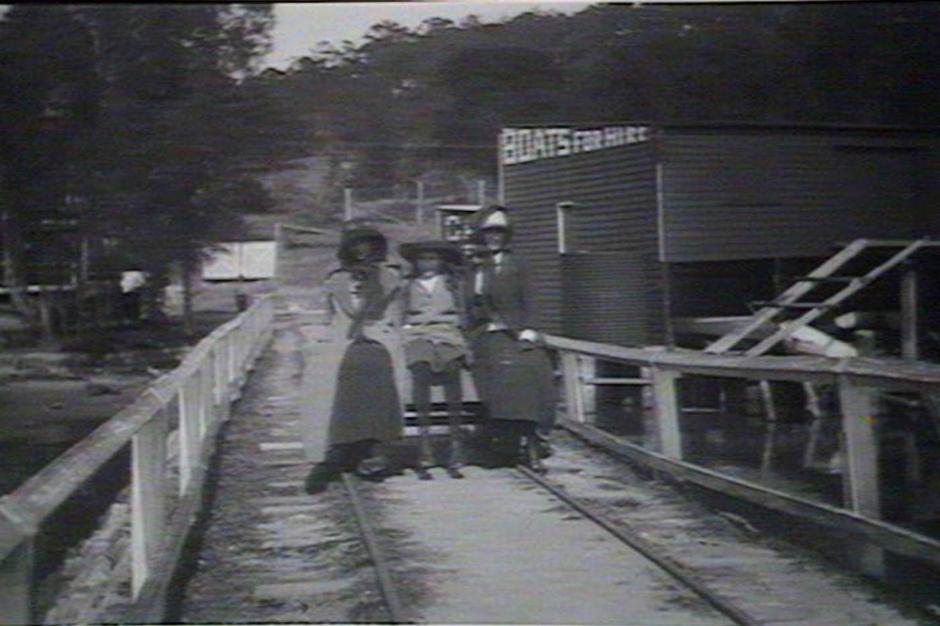
Is this photo of three women on Bayview Wharf the Roche Girls?; The noses would have it that it may very well be either Elizabeth Ellen ‘Nellie’ (1886) Mary Honorah (Born 1888) Katherine Agnes T (born 1889) and youngest girl Nano Ellen – became a nun (born 1892) - the lady on the far right may even be mother Katherine Mary Roche herself! - They are sitting opposite the entrance to where the family cottage and Bayview Post Office was - the Roche Estate.
After the death of her husband, James Joseph Roche, Katherine sold some portions of her lands, perhaps in part to meet death duties, and also because she wanted to move her children, still then young, closer to 'the city' - Mosman, for education, work, health reasons.
Bayview Wharf, three women on slipway trolley by Cecil S Harnett - GPO original locations or series - Macleay Museum: circa 1900-1910, Image No.: d1_04882, courtesy State Library of NSW.
Cecil Harnett's family were connected with Mosman from its earliest days, and he frequented Balmoral Beach, which was also the sand and saltwater bay below the Roche Mosman home. There is also another connection with the Harnett's in the form of Cecil's sister, Nurse Harnett (later Matron) who conducted Nurse Harnett's Private Hospital, originally opposite the Warringah Bowling Club and then in Ellamatta Avenue as 'Glengarry'.
Katherine Mary Roche
1853 to April 14, 1943
Katherine Roche was the youngest daughter of John and Honorah Collins, married June 12th, 1847, known by many as the 'father of Pittwater'. Her eldest son, John Roche, was known as 'the soul of Pittwater' as well as 'father of the Pittwater Regatta’.
Whiffs From Pittwater - JOHNNY ROCHE celebrated his twenty-third year of office as secretary of Pittwater Regatta on Saturday, but there was a whisper round Newport and Bayview after the termination of the carnival that the 'soul of the district' will not be a candidate for the office next year. Johnnie's burdens have been mounting up in recent years and he feels that it is up to somebody else to take up the work of running a gigantic aquatic gala. Whiffs From Pittwater. (1929, December 31). Sydney Sportsman (Surry Hills, NSW : 1900 - 1954), p. 13. Retrieved from http://nla.gov.au/nla.news-article166465144
This lady had to make hard decisions, run a small empire and look after young children when widowed as well as cope with one of the earliest confirmed cases of polio in Pittwater. Records indicate one of the two sons of her elder sister Ellen may also have been inflicted.
Katherine should also be credited with the fact that we have a Bayview recreation area, which those who came after her times may not be aware of. Her generosity, a nature that was intrinsic in succeeding generations of Collins and Roches, proved a dedication to giving to and doing for others even during your own testing times was part of these families nature.
Katherine was the daughter of two people from Cork, Ireland - a coastal part of Erin where sailing, rowing, fishing or being part of a landscape that meets the seascape is part of life. The valley of Avalon could have reminded the Collins family of home and as Jeremiah Collins, father of John, had been evicted from his holding of 50 acres on the ESTATE OF PIERCE NAGLE, ANNAKISSY in 1839, a way to keep themselves independent of such experiences would have made Katherine's father determined to own land here.
Interestingly Pierce Nagle was the nephew of Nano Nagle(christened Honora), founder of the Presentation Order of Nuns, a forerunner of schools for the poor, and a name which would be given to Katherine's youngest daughter.
We can see little of Katherine while growing tall apart from that glimpse given by Charle's de Boos in his 'My Holiday' series of articles when she would have been around 8 years old:
After crossing the creek, we came in sight of a homestead, small but neat, having evidently been only recently whitewashed. The paddock was now clear of all undergrowth, and, as a goodly cluster of large trees, the remnants of the former occupants of the soil, had been left standing round the house, it had an exceedingly pretty and picturesque appearance, its white sides gleaming out markedly from amongst the bright green of the shrubs around it, and the dark and sombre verdure of the forest monarchs that overshadowed it.
"This," said Tom, "is Tom Collins, and he's the man that will show us the cave."
“The cave ?" asked I. "What cave ?".....
A tap at the door brought out the mistress of the house, accompanied by her brood of little ones, all fat, chubby, and rosy faced, bearing on their countenances the imprimatur of good health. Having mentioned our errand, we were invited to enter, and we found the interior of the domicile even more neat, and white, and bright, than the exterior, for it was the very beau ideal of cleanliness, and care. The tin-ware which hung from the shelves was polished till it shone like silver, whilst the shelves themselves being of deal, were scoured almost to whiteness. The floor, though an earthern one, was swept so clean that it more resembled a single large slab of stone than what it really was; and the fire in the huge bush fireplace was nicely kept in the centre, each side being swept as carefully as the floor itself had been. The hut had been recently whitewashed throughout, and the whole had such a light and cleanly air as strongly to remind me of some of the farmhouses it has been my lot to visit in the mother country, where, perchance, some notable housewife would take such a pride in polishing that even to the iron hoops of the churn, the piggins or the milk coolers would be burnished up till they resembled steel.
Unfortunately our man, Tom Collins, who knew all about the cave, and who was, in fact, its first discoverer, was absent from home; his brother, however, would very willingly guide us to the spot, so said Mrs. Collins, and waiting the arrival of her brother-in-law, she brought forth a huge jug of milk, from which she desired us to help ourselves; and if Tom and Nat didn't do so to a pretty considerable extent, they made a very good attempt at it, that's all. I verily believe that they would have had impudence enough to have asked for another quart, had not the arrival of Collins frer turned their attention to another quarter. He at once expressed his willingness to conduct us, and furnished himself with a piece of candle, the interior part of the cave being so dark as to require a light for guidance amongst the fallen rocks that encumber it....(To be continued.) MY HOLIDAY. (1861, September 2). The Sydney Morning Herald (NSW : 1842 - 1954), p. 3. Retrieved from http://nla.gov.au/nla.news-article13057913
‘In the midst of life we are in death' was sadly illustrated in the case of Mr. John Collins, of Pittwater, on Friday night, the 20th inst. Mr. Collins came up the Sunday before to attend the sale of the Pittwater estate, which took place on the 16th inst., his 66th birthday. From Monday to Friday he was making arrangements with a contractor for the erection of a cottage on one of his farms. Returning from Sydney on Friday evening by the half past 5 boat he fell overboard at Lavender Bay wharf, through, it is supposed, the bumping of the steamer against the piles. Owing to the noise of the engine the accident was not observed on the instant, and some short time had elapsed before Captain Butler, who has saved scores of lives from drowning, plunged in to the rescue. He soon brought Mr. Collins on board and proceeded with his steamer to Milson's Point, when he placed him in a cab which conveyed him to his brother-in-law's (Mr. Connolly), the Union Inn. Father Kennedy, S.J., and Dr. V. Browne were immediately in attendance, and both had strong hopes of his recovery until about 1 o'clock at night, when capillary bronchitis supervened. The deceased gentleman was an old colonist, having emigrated from Cork with his parents about 50 years ago. He was well known and widely respected, not only in Pittwater, where he was regarded as a patriarch, and where he resided for upwards of forty years, but also in the North Shore and in Sydney. He was a man of sterling principle, so fond of the right that he would not do wrong deliberately for a kingdom. He had a great contempt for the worldliness, avarice, and selfishness so characteristic of the present times, his own character being the very antipodes of these. On Monday morning a Requiem Mass for the repose of his soul was celebrated by Father Kennedy in the church of St. Mary Star of the Sea. The respect in which Mr. Collins was held was testified by the numbers of all classes who attended his funeral, which was the largest of any private funeral that has taken place here for the last twenty years. He leaves a widow, four sons, and a daughter, all, except one of the sons, living in Pittwater. May his soul rest in peace. ST. LEONARDS. (1881, May 28). Freeman's Journal (Sydney, NSW : 1850 - 1932), p. 10. Retrieved from http://nla.gov.au/nla.news-article115457523
The Collins stayed in Pittwater, now land-owners at Careel Bay. On 8 September 1881 Honorah Collins purchased from Therry’s estate the 80 acre grant at Bayview, next to Winnyjimmy Swamp, for £80, which was the market value of the land at the time. [LTO Book 229 No. 144] Honorah and her daughter Katherine lived at Bayview, Katherine taking on the duties of Post Mistress to the growing Bayview area on 21 August 1882. - PROFILES OF THE PIONEERS IN MANLY, WARRINGAH AND PITTWATER by Shelagh Champion, OAM, B.A.(Lib.Sc.) and George Champion, OAM, Dip.Ed.Admin. Revised 2013.
A report on request for a Post Office at Bayview:
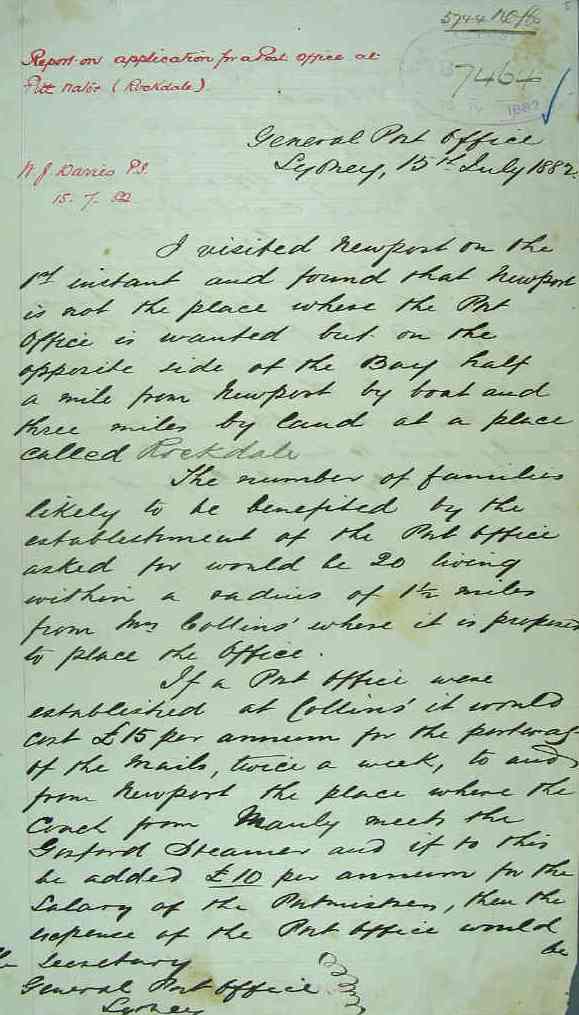
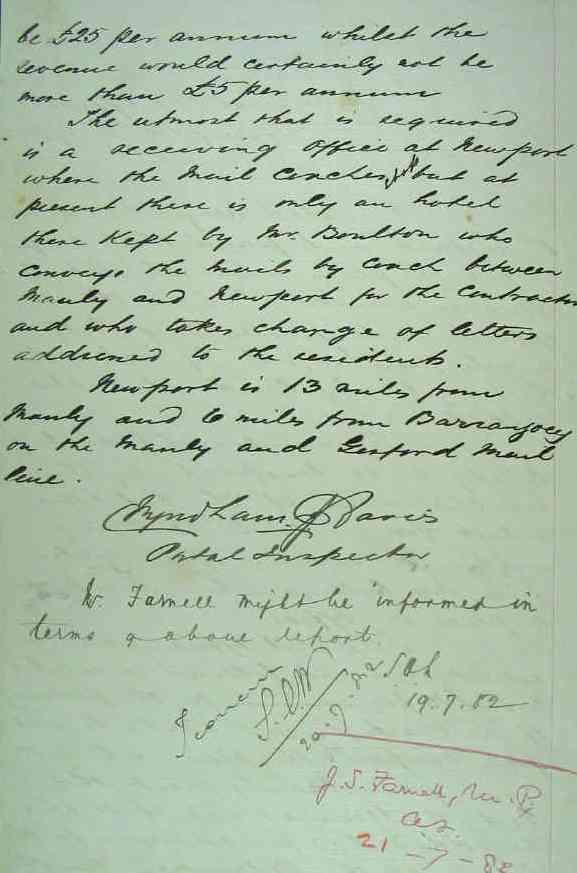
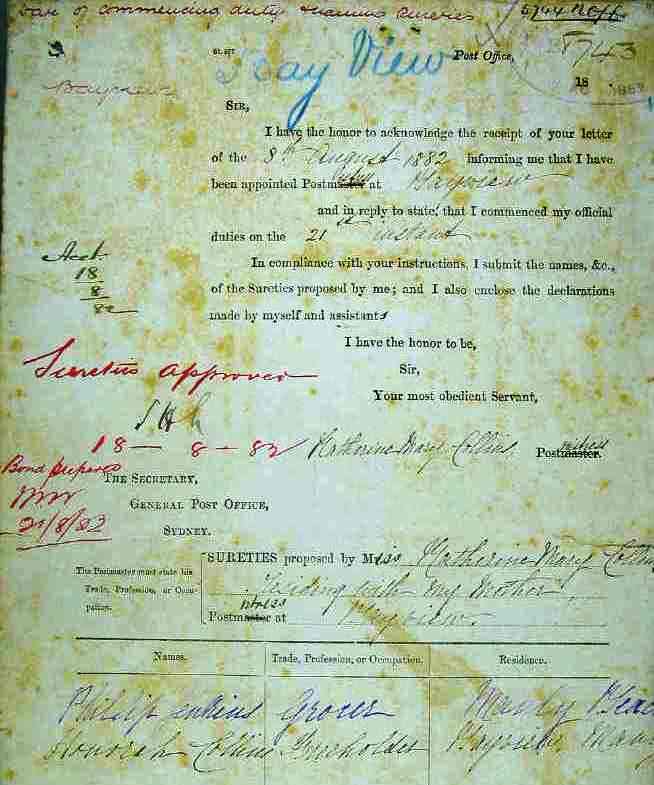
Soon afterwards Katherine married:
ROCHE—COLLINS.—April 18, at the residence of the bride's mother, Rockvale, by the Rev. Dean Hanly, James Joseph, youngest son of John Roche, Esq., County Cork, Ireland, to Katherine M., youngest daughter of the late John Collins, Esq., of Pittwater. Family Notices. (1883, May 24). The Sydney Morning Herald(NSW : 1842 - 1954), p. 1. Retrieved from http://nla.gov.au/nla.news-article13535436
They had six children: John (born 1884 - October 15, 1936) Elizabeth Ellen ( February 5th 1886 - 8 Apr 1979) Mary Honorah (Born 1888 - 26 Jul 1979) Katherine Agnes T (born 1889 - 13 Jul 1976) Nano E (1892- 29 Sep 1979) Francis Michael G (Born 1895)
And while the Roche family grew, their father's success as a farmer accounts for a few reports:
Successful Poultry Farming. WRITTEN FOR THE 'TOWN AND COUNTRY JOURNAL.' (BY " ST. MAGNUS.")
There can be no doubt whatever that poultry fanning will pay, providing that the proper conditions for the successful rearing of the fowls are present and that ' skill is' brought to bear on the business. Many men enter, upon this business without any previous experience at all, ' and in such 'cases' failure is the general result. To make the business successful the fowls must have plenty of run, their houses and roosts must be kept scrupulously clean, the best breeds of fowls must be selected, and they must receive intelligent and careful attention. Uncombined with any other agricultural pursuit, poultry farming seldom pays unless in the hands of an expert, and even then it will pay better if combined with' some pursuit such, as fruit or vegetable growing. Some of the most successful poultry-breeders of New South Wales, are fruit growers. It stands to reason that where fowls can be largely fed on the waste accruing about such premises, they can be more profitably reared than in a place where the whole of-their food must be purchased.
One of the most successful poultry-breeders of the country is Mr. J. J. Roche, Bayview, Pittwater. This gentleman combines poultry-breeding with fruit growing, he having 30 acres of a flourishing orchard, and making a, successful business of both pursuits. Briefly described, Mr. Roche's method is about as follows : His land (a light loamy soil, high, and dry, having a north-eastern aspect, with plenty of shells, sand, and grit in its natural composition) presents the ideal conditions for a poultry farm. The principal breeds he keeps are Langshans, Plymouth rocks, brown and white Leghorns, Houdans, Minoreas, Brahmas, Orpingtons, Spanish, Hamburgs, Dorkings, and colonial game, and Aylesbury and Pekin ducks. These he keeps fenced off in separate enclosures, giving them plenty, of room and plenty of shade. This order is, however, only observed during the breeding or mating season, after which, the birds are. allowed to assemble in flocks and to have an extended min. Mr. Roche hatches almost wholly by the incubator, and with moderate attention attains a high degree of success, getting on the average 90 per cent. He rears his chickens by foster-mother, consisting of iron tanks filled with hot water, sometimes, however, using hens in conjunction with the artificial mothers. The plan is to set a broody hen, and slip 12 chickens, hatched by the incubator, under her at night, when she will take to them as if they were her own hatching, and rear them, Mr. Roche believes that to cleanliness and feeding is due in a great measure, his success. He feeds principally on soft food, giving pollard mixed up into a stiff dough in the morning. The pollard should be moistened only to that consistency that when thrown on the ground it will crumble. Sometimes a little wheat is mixed with the pollard, and occasionally maize is given to color the eggs a bright red but maize is too heating to make it a regular diet. Garden feed, as a matter pf course, is given regularly, meat once or twice a week if it can be got, and sour milk when available..
Mr. Roche is particularly strict about his drinking fountains, and sees that they are kept clean and constantly supplied with pure, fresh water. Sulphate of iron is given as a tonic in the drinking water-as much as will lie on a penny piece in a bucket of water once a; week; This keeps the fowls free from disease, and gives them appetite for their food. His drinking vessels (see figures: 1 and 2) are simple of construction, yet eminently adapted for the purpose intended. Figure 1 shows a kerosene tin with holes cut in it(as shown in the engraving) through which the fowls thrust their heads, fill their mouths, and withdraw it to swallow the water.
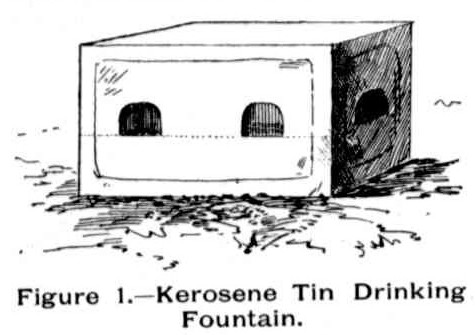
Figure 1.-Kerosene Tin Drinking, Fountain.
The advantage of this contrivance over an open vessel is that in the first place the water is kept cooler and purer, and in the second place the fowl, having to withdraw its head to swallow the water, any that may escape from its mouth in this ' operation falls on the ground instead of falling in the vessel as it inevitably would do, providing it was open, and the fowl stood over it to drink. The advantage of this contrivance then, is obvious, for - disease is but too frequently "communicated from one fowl to another by the slime and drippings that fall from diseased birds bills into the drinking-water. Figure 2 shows-another kind of drinking fountain;-
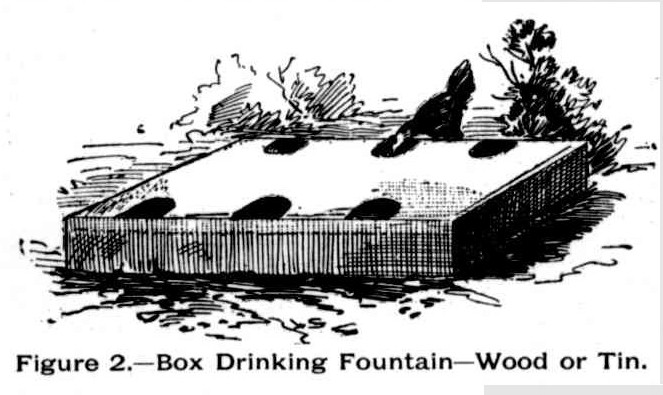
Figure 2.-Box Drinking Fountain-Wood or Tin.
It may be a wooden box or tin, or iron vessel-of say-5in. deep', covered on the top as seen in the engraving; but -having holes through which the fowls may thrust the bills to drink. This contrivance does not however meet with the some approval from Mr. Roche as the other, for although the cover keeps the water clean, yet the fowls may stand over it and drink and the slime and drippings, from their bills majrind its way into the water through the holes- and so contaminate it. . Mr. Roche has experimented much with fowls by crossing one breed on to the other, and sometimes with the best results. First, he is a great believer in the langshan as a general purpose farmer's fowl. They are good layers, good table fowls, hardy, fast growing, and docile. Next to them comes the brown and white Leghorns, so well and favorably known to poultry keepers. The Leghorns, however, lays a small egg, and they are small birds for the table. A cross between the Langshan and the Leghorn he, however, finds to bean excellent bird, and partakes .and combines the good qualities of both. He has also experimented extensively with other crosses; and is on the whole well pleased with the result. The colonial game he places before the British game as being better adapted to our climate and for table purposes. He considers his fowls pay him well, and there is room for an extension-of the business. It may be said that the whole district around Broken Bay is in every way adapted for poultry keeping. The climate is all that could be desired, and the soil is heavily impregnated-with shells and grit. The land has a good elevation, and there is an abundance of pure, fresh water and plenty of shade and green feed,- then it is close to market, and a man in his spare moments can always find something to employ his time working on the land. The district ought to be an excellent one for the beekeeper, as there are plenty of blooms and a wide scope of country for the bees to range over. There are, however, few apiaries of any pretensions in the district as yet, but various of the settlers are thinking of starting them. Successful Poultry Farming. (1893, November 18). Australian Town and Country Journal (NSW : 1870 - 1907), p. 22. Retrieved from http://nla.gov.au/nla.news-article71191960
The Late Agricultural Show. We regret that we omitted to record in the prize list of the late Sydney Agricultural Show the fact that Mr. J. J. Roche, Bayview, Pittwater, won first prize in preserved fruit in syrup, beating some very choice collections. Mr. Roche also secured second prize in mandarin oranges. Mr. Roche is the owner of a very fine Orchard and poultry farm at Bayview, Pittwater, and he writes that he is bottling his peaches and apricots, and makes it pay well, and in his opinion it is the only way to make fruit pay at the present prices. The Late Agricultural Show. (1895, May 4). Australian Town and Country Journal (Sydney, NSW : 1870 - 1907), p. 48. Retrieved from http://nla.gov.au/nla.news-article71229161
To the duties of postmistress were added Telephonist, after a petition from residents, commencing September 1893. We place all four pages of this, retrieved from National Archives of Australia, as it illustrates Pittwater was not as uninhabited as all the references to 'in the wilderness' may state:
Petition 1:
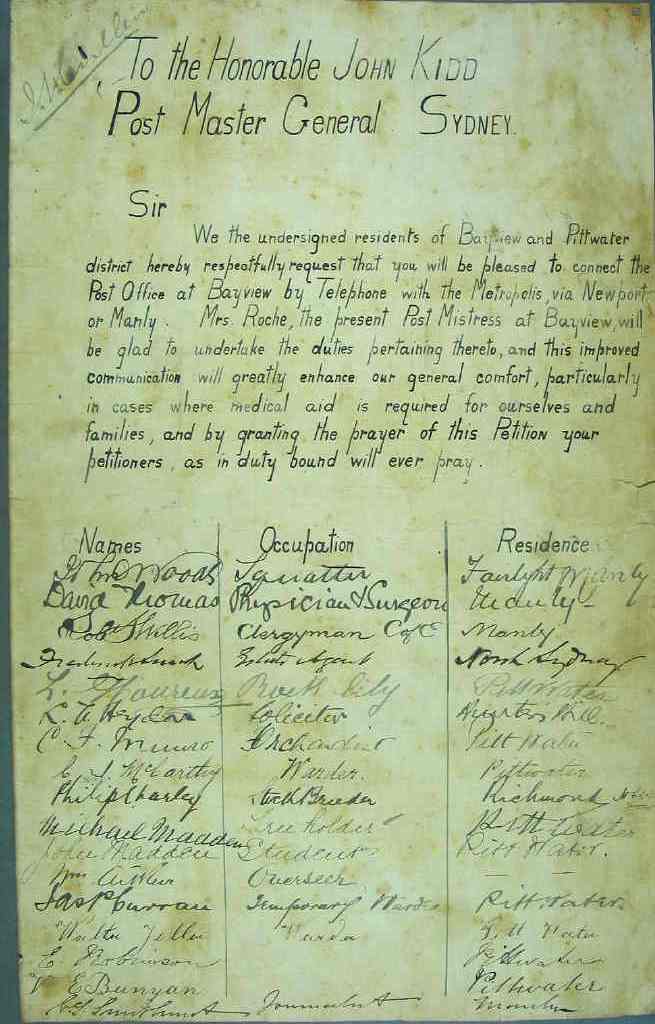
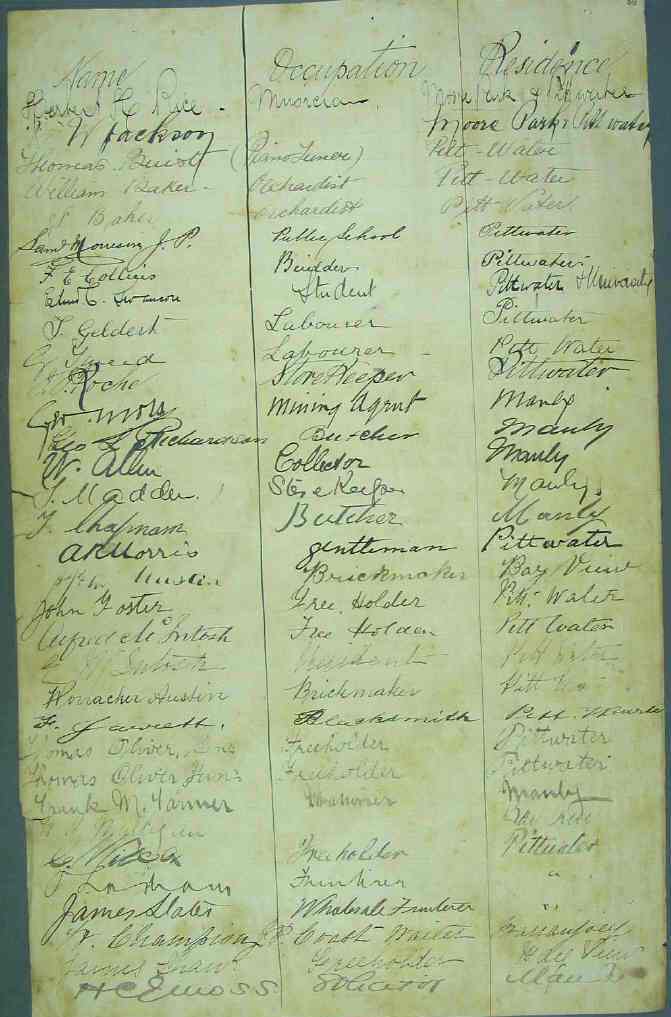
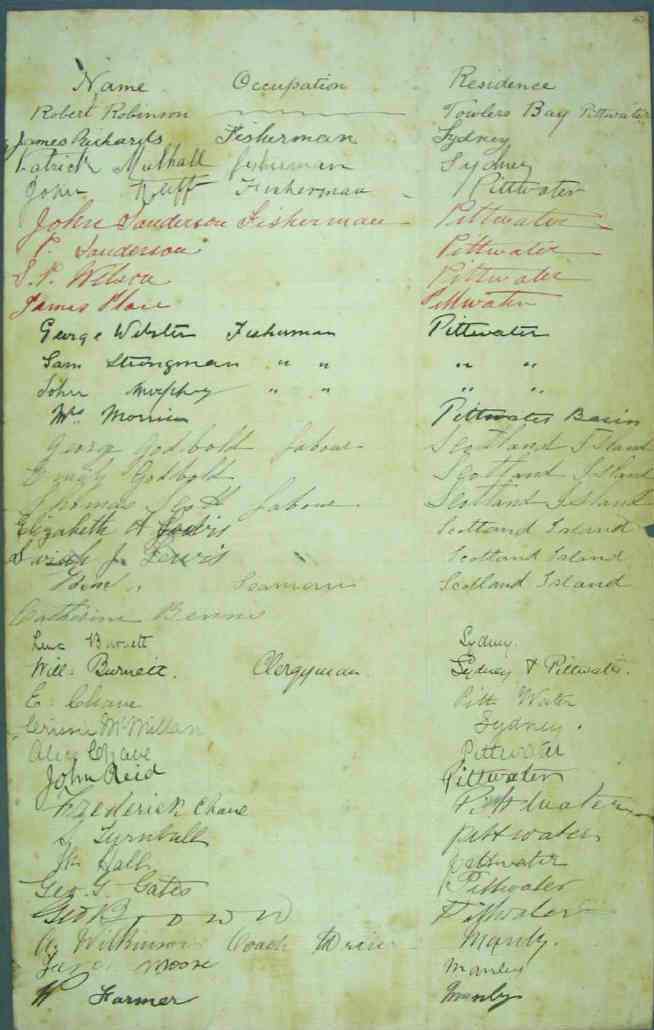
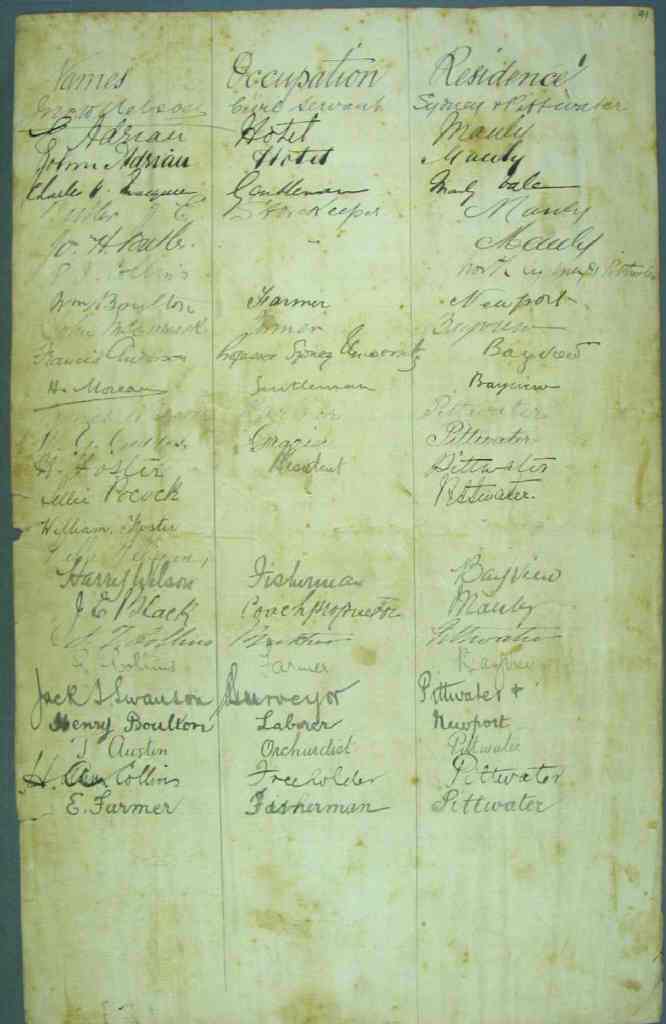
Petition 2:
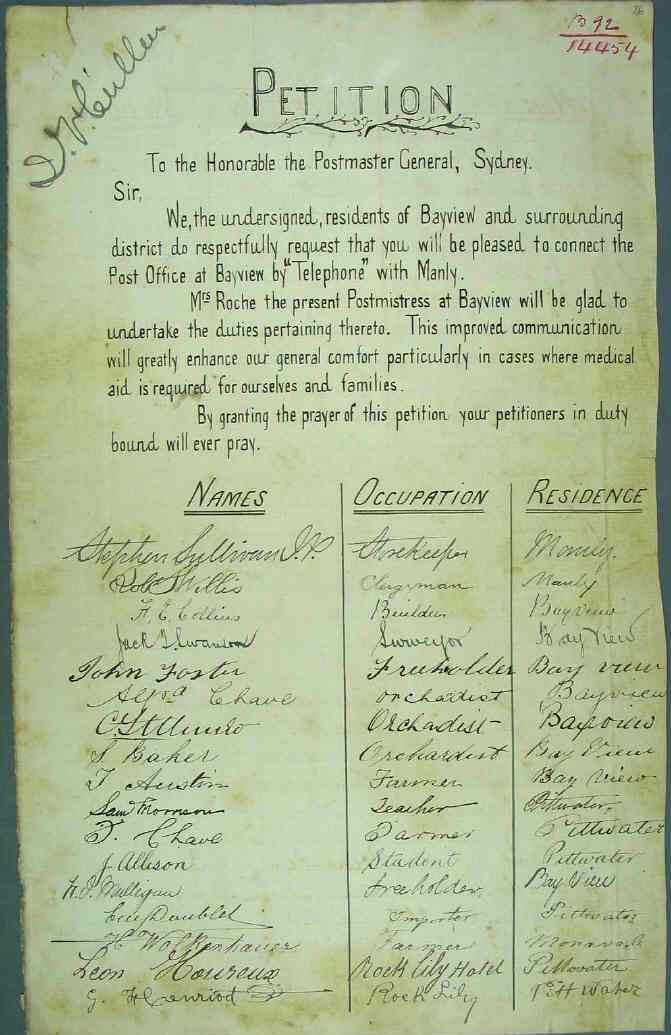
Note; Joseph Bens - with on 'n'
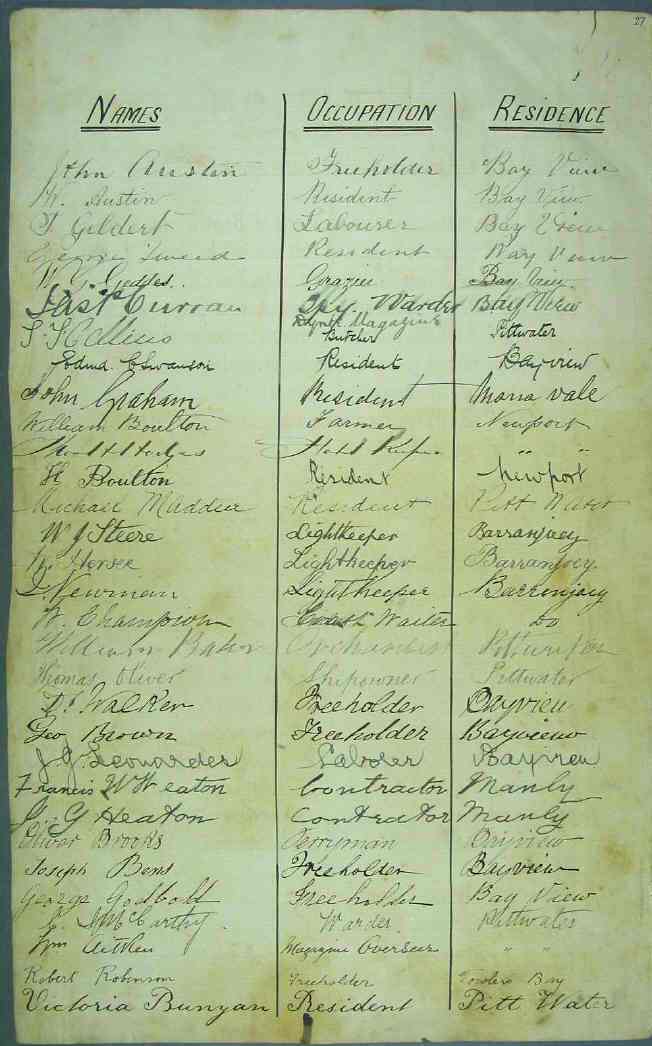
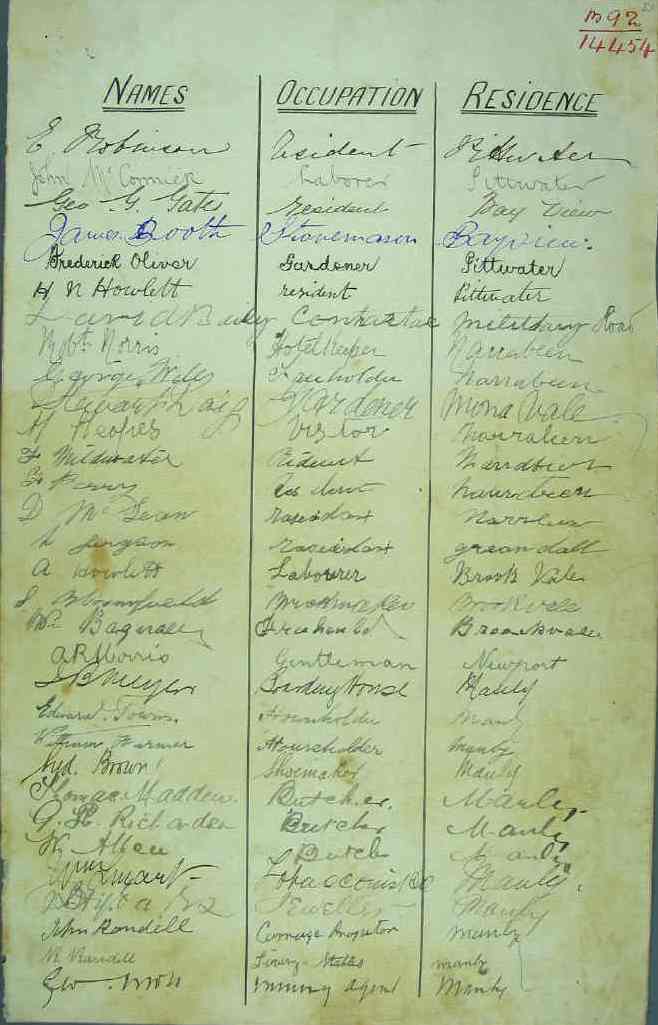
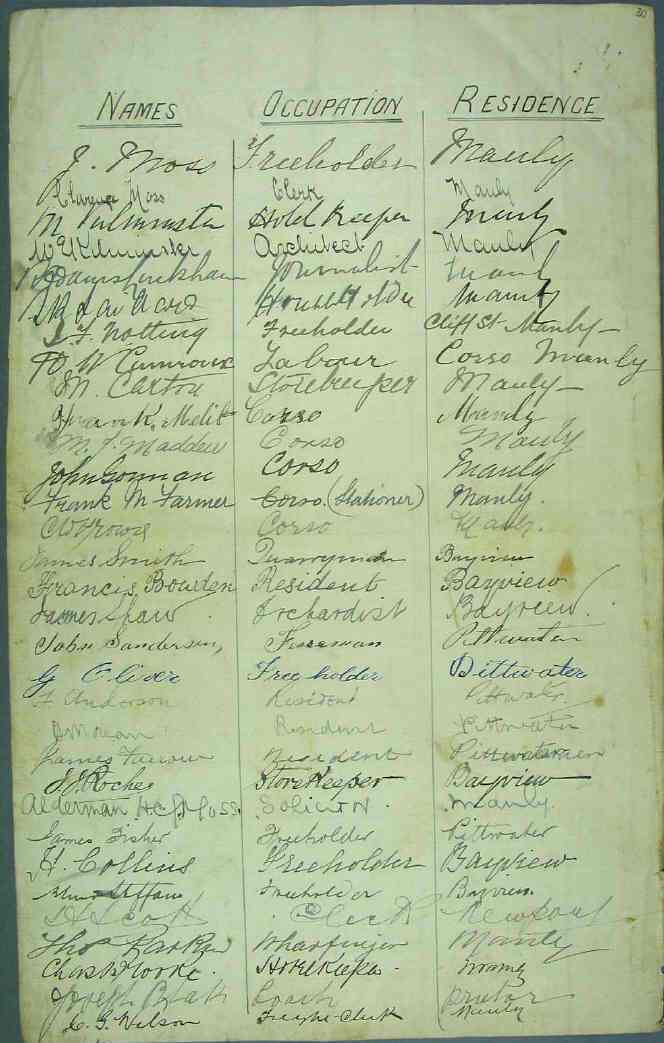
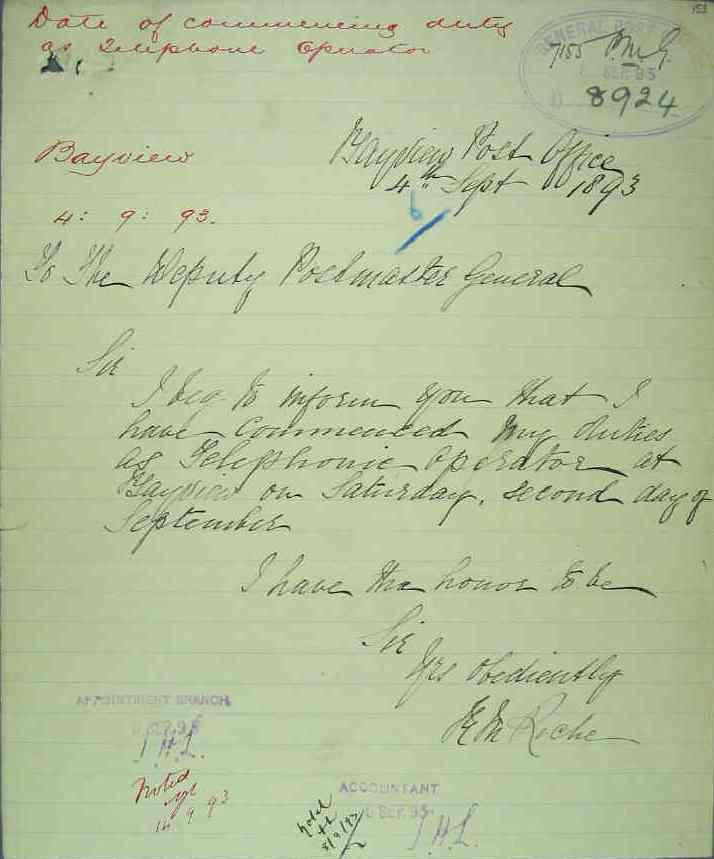
Their premises, doubling as a post-office and store, was the place to visit for dignitaries ads well as a voting place and where community meetings were held. Some of these reports show when researching people to celebrate and honour their contributions that their surnames can be mistakenly misspelt:
COMPLIMENTARY PICNIC TO MR. DUGALD THOMSON, M.L.A.
On Saturday last the several committees who were formed to secure the return of Mr. Dugald Thomson as member for Warringah tendered to that gentleman a complimentary picnic the arrangements were in the hands of the hon. secretaries of the various committees, namely -Messrs G. J.Barry, of Neutral Bay ; John Blackwood, of Pittwater , J. G. Cannon, of Mosman , W. M'Clelland Inglis, of Sydney , and O H. Warburton, of Manly. The metropolitan contingent left Sydney by the1 p m. boat, and were met at Manly wharf by many villagers, with whom, in well appointed coaches, they wore driven to the Rock Lily Hotel, picking up on route members from ... and Narrabeen. The afternoon was spent in inspecting Mr J J. Roach's orchard at Bayview, enjoying the charming scenery of Pittwater, whose waters lay calm and unruffled in the sunshine which favoured the occasion, and after sampling the oranges generously placed at their disposal, the party returned to the Rock Lily for dinner. Host Houreux had provided for 70, but no less than 100 presented themselves, yet he gave them all an excellent repast. Representatives were present from the whole of the Warringah electorate. Apologies for absence were read from many gentle-men The chair was occupied by the Mayor of Manly, and the vice-chair by Mr. Leonard Dodds. After the toast of the " Queen " had been honoured the toast, "Our Guest, Mr Dugald Thomson," was proposed by Alderman Fletcher of Manly, seconded by Mr. J. Barre Johnston, and supported by Mr. Leonard Dodds, Dr Cullen, M.L C. , and Mr. P. T. Taylor. Mr. Dugald Thomson. M L A , who was received with loud cheers, said that he had to thank his committees most cordially for their invitation, and owed them another debt of gratitude. He was proud to know that by going straight and fulfilling his pledges he had gained the support not only of his former adherents but also of some who at one time were opposed to him, and this not withstanding the fact that his action in following Mr. Barton had been misconstrued. He felt satisfied that federation must receive the earnest attention of the House, because it was essentially a federal Parliament, and he would be willing to give Mr. Reid his support if that gentleman proved himself true in the cause of federation. He concluded by again thanking the electors for his return, and congratulated his committees upon the successful work they had performed.'' The third toast was "Federation," proposed by Mr, J, J. Cohen, M.L A., seconded by Mr. T. West, and the last was .. Mr Thomson," proposed by Mr. 0. H. Warburton, and honoured with acclamation. With the usual thanks to the chair, the party adjourned to a smoke social, and after an hour's enjoyment returned to Manly by instalments in time to catch the steamers for Sydney. COMPLIMENTARY PICNIC TO MR. DUGALD THOMSON, M.L.A. (1898, August 8). The Sydney Morning Herald (NSW : 1842 - 1954), p. 5. Retrieved fromhttp://nla.gov.au/nla.news-article14138961
MR. DUGALD THOMSON AT BAYVIEW. On Friday evening Mr. Dugald Thomson, M.L A., addressed a meeting of the electors of Bayview. There was a good attendance Mr. J. Symonds (president of the progress association) presided. There were also on the platform Messrs. Roche, Morrison, Austin, and Blackwood. Mr. Thomson received a quiet and attentive hearing. He dealt with the democratic features of the bill, explained the provisions for deadlocks, and said it was impossible that any majority could represent any particular State in the Senate He also dealt with the matter of the capital, and pointed out some of the moat patent advantages which would accrue to New South Wales and the whole of the federating colonies. On the motion of Mr. J J. Roche, seconded by Mr. Austin, a vote of thanks was carried by acclamation to Mr. Thomson, and hearty cheers for federated Australia were given. MR. DUGALD THOMSON AT BAYVIEW. (1899, May 30). The Sydney Morning Herald (NSW : 1842 - 1954), p. 7. Retrieved from http://nla.gov.au/nla.news-article14251662
It was during this time that Katherine's mum passed away and James lost his brother:
ROCHE -March 21,1897, John Roche, Q.C., of Summerville, Cross-avenue, Dublin, late Co. Court Judge for Down, eldest son of the late John Roche, Co. Cork, and brother of J. J. Roche, Bayview P.O., Pittwater. Family Notices. (1897, May 22). The Sydney Morning Herald(NSW : 1842 - 1954), p. 1. Retrieved from http://nla.gov.au/nla.news-article14121702
ROCHE.—In loving memory of John Roche, Q.C., who died at his residence, Summerville, Dublin, 23rd March, 1897, late County Judge for Down, eldest brother of J. J. Roche, Bayview, Pittwater. R.I.P. Family Notices. (1899, March 23). The Sydney Morning Herald(NSW : 1842 - 1954), p. 1. Retrieved from http://nla.gov.au/nla.news-article14205814
DEATH OF MRS. COLLINS. Full of years spent worthily, Mrs. Honora Collins relict of the late John Collins, died on the 20th instant the residence of her son-in-law, Mr. J. J. Roche, Bay View, Pittwater. For more than half a century she had lived at Pittwater, and no family was better known or more highly respected than the Collins family of Careel Bay. Mr. and Mrs. Collins were natives of the County Cork, whence they emigrated 60 years ago. Soon after their arrival in the colony they settled on Father Therry's grant at Pittwater, where Mr. Collins engaged in grazing and farming. The district has always been a great health resort. Many an invalid from Sydney recruited his health at the hospitable homestead of the Collins family. The cottage was flanked by two hills, named Mount St. Joseph and Mount St. Mary by Mr. Collins. It is told of him that he would allow none of his sick guests to leave until he saw that they were completely 'on their legs,' his test for which was a given time to ascend and descend these hills before breakfast. The remains of the deceased lady were brought on the 21st from Bay View to St. Mary's, North Sydney, where Masses were said for the repose of her soul. The funeral took place at Chatswood Cemetery, the family burial-place, the same day. The chief mourners were Mr. J. Collins, of the Harbours and Rivers Department; Mr. P. Collins (sons); Mr. J. J. Roche, son in-law; Messrs. J. T. and E. P. Swanson, nephews. Among others present were Mrs. Black, of Barrenjoey Customs Station, Mrs. Midden, Mrs. Roche, Mrs. Earl, Mrs. Robertson, Mrs. F. Collins, Mrs. P. Collins, Messrs. D. J. Glacken, M'Teague, J. Wall, J. Crowley, H. Coyle, J. Macintosh, and Boulton. The Rev. Father Dowling, of St. Patrick's College, Manly, attended Mrs. Collins during her last illness, and officiated at the grave. May her soul rest in peace. DEATH OF MRS. COLLINS. (1897, October 30). Freeman's Journal (Sydney, NSW : 1850 - 1932), p. 16. Retrieved from http://nla.gov.au/nla.news-article115471628
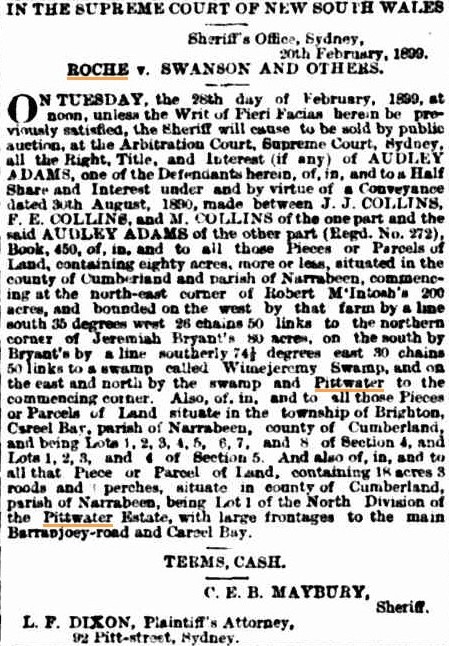 Audley Adams tries selling property out from under Katherine. Imagine finding this in the paper!
Audley Adams tries selling property out from under Katherine. Imagine finding this in the paper!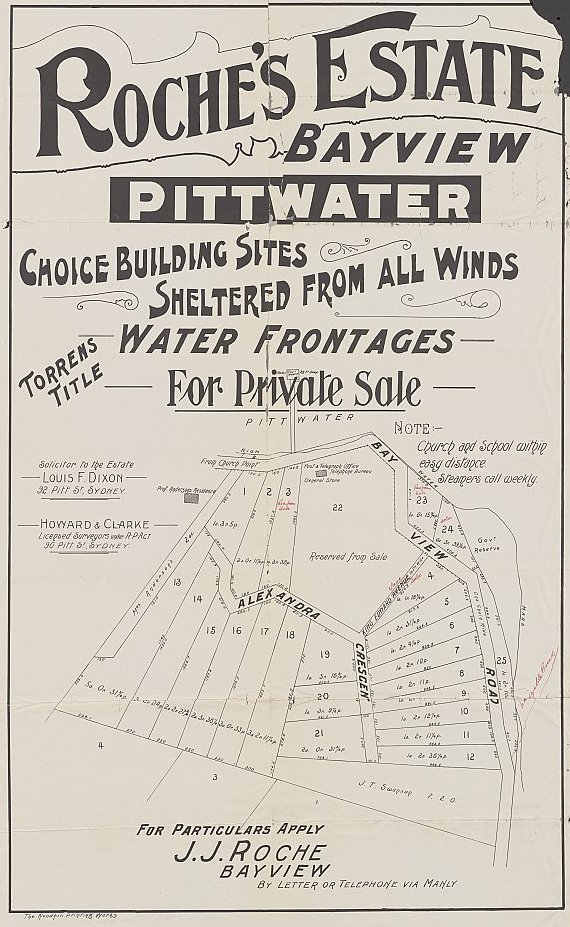
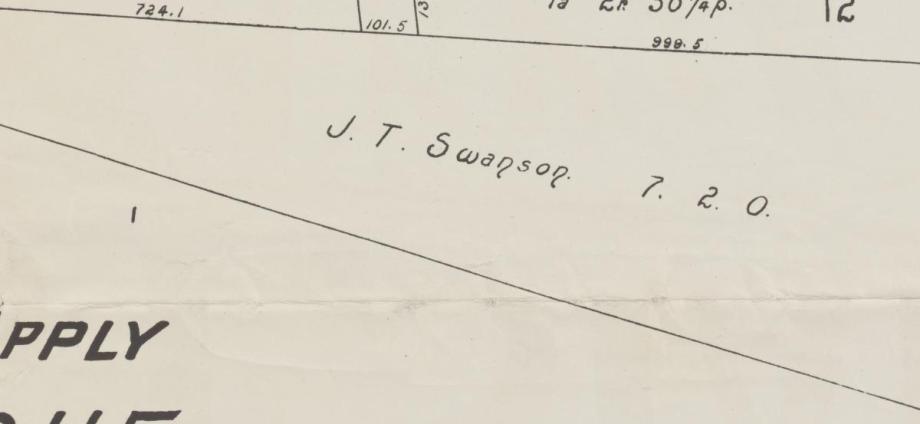
SWANSON. — At her father's residence, Pittwater, on the 6th instant, Ellen, the beloved wife of Charles Swanson, Esq., and eldest daughter of John Collins, Esq.,aged 26. Requiescat in pace. Family Notices. (1874, October 10). Freeman's Journal(Sydney, NSW : 1850 - 1932), p. 8. Retrieved from http://nla.gov.au/nla.news-article11547820
SWANSON — On April 7th, at Forbes, Charles John Swanson, son-in-law of John Collins, Pittwater, aged 39 years. Requiescat in pace. Family Notices. (1878, April 20). Freeman's Journal (Sydney, NSW : 1850 - 1932), p. 12. Retrieved from http://nla.gov.au/nla.news-article111098081
Manly Horticultural Society. The second show in connection with the Manly Horticultural Society was opened yesterday afternoon in the Oddfellows' Hall. The judging, however, did not take place till late in the afternoon. The collection of palms and pot plants reflected much credit upon the exhibitors, while the cut flowers, including an excellent collection of chrysanthemums by Mr. C. H. Wickham, were of a most commendable description. Mr. J. J. Roche, of Bay View, had on view some splendid specimens of bananas, persimmons, citrons, lemons (two on one stalk weighing 3lb),valetta oranges, mandarins, guavas, passion fruit, all grown at his orchard, and some preserved fruits in bottles which were highly approved. Mr. Roche had also an exhibit of poultry, comprising a pair of colonial game fowls, the male bird weighing over 12lb, and. a pair of Langshans seven months old. The same gentleman showed some specimens of the 'Mrs. Bell' camellia grown by Mr. Swanson, his son-in law. Manly Horticultural Society. (1894, April 14). Evening News(Sydney, NSW : 1869 - 1931), p. 5. Retrieved from http://nla.gov.au/nla.news-article114076522
SWANSON.— THE FUNERAL of the late EDMUND CLEMENT SWANSON will leave St. Vincent's Hospice, at 1.30 p.m. sharp, THIS (SUNDAY), for St. Mary's Church, North Sydney, thence at 2.30 p.m. for the R.C. Cemetery, Chatswood. Mrs. P. KIRBY and SON, Undertakers, 7 Elizabeth street. Family Notices. (1901, December 29). Sunday Times (Sydney, NSW : 1895 - 1930), p. 2. Retrieved fromhttp://nla.gov.au/nla.news-article125886562
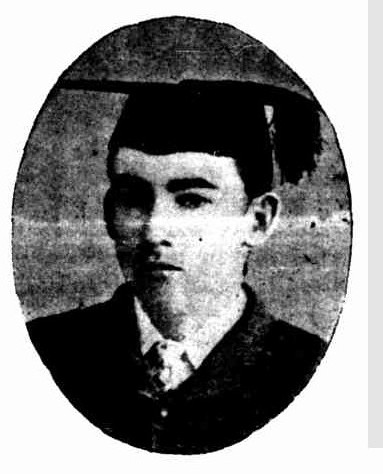 DEATH OF MR. E. C. SWANSON, B.A. Keen regret was felt by the many friends and relatives of Mr. Edmund Swanson, B.A., when his death was reported at the Sacred Heart Hospice on December 28 last. Deceased, who had never been of a robust constitution, had been in doubtful health for a few weeks, but it was not such as to give alarm to his friends, and therefore the suddenness of his end had not been expected. At the Hospice, which he attended by the Very Rev. Dr. Carroll, V.GL, and needless to say he was watched with every care by the good Sisters in charge of that institution. Mr. Swanson was an 'old boy' of St Joseph's College, Hunter’s Hill. In that institution he distinguished himself by matriculating at the early age of 14, and gaining first class honours in mathematics, far which he had a special bent. He also secured second place for the Barker Scholarship. Entering St. John's College he won the Rector's Scholarship for mathematics, and obtained his degree in 1893. His career at the University was thwarted by the uncertain state of his health, and he had to be satisfied with taking an ordinary B.A. degree instead of securing it with first-class honours, as might reasonably have been expected. After leaving the University he took a position as teacher of classics and mathematics at St. Stanislaus' College, Bathurst. Though for a number of years suffering considerable pain he bore up manfully, and remained all through deeply resigned to the will of God in his regard. What would have been a triumphal march in the intellectual world but for the barrier imposed by his health, was not to him a subject to brood over ; he did not believe in playing the role of the disappointed man ; rather was he satisfied to make the best of circumstances, knowing the wisdom of conforming in all things to the will of God. His end was a most peaceful one. R.I.P. DEATH OF MR. E. C. SWANSON, B.A. (1902, January 18).Freeman's Journal (Sydney, NSW : 1850 - 1932), p. 17. Retrieved from http://nla.gov.au/nla.news-article111070958
DEATH OF MR. E. C. SWANSON, B.A. Keen regret was felt by the many friends and relatives of Mr. Edmund Swanson, B.A., when his death was reported at the Sacred Heart Hospice on December 28 last. Deceased, who had never been of a robust constitution, had been in doubtful health for a few weeks, but it was not such as to give alarm to his friends, and therefore the suddenness of his end had not been expected. At the Hospice, which he attended by the Very Rev. Dr. Carroll, V.GL, and needless to say he was watched with every care by the good Sisters in charge of that institution. Mr. Swanson was an 'old boy' of St Joseph's College, Hunter’s Hill. In that institution he distinguished himself by matriculating at the early age of 14, and gaining first class honours in mathematics, far which he had a special bent. He also secured second place for the Barker Scholarship. Entering St. John's College he won the Rector's Scholarship for mathematics, and obtained his degree in 1893. His career at the University was thwarted by the uncertain state of his health, and he had to be satisfied with taking an ordinary B.A. degree instead of securing it with first-class honours, as might reasonably have been expected. After leaving the University he took a position as teacher of classics and mathematics at St. Stanislaus' College, Bathurst. Though for a number of years suffering considerable pain he bore up manfully, and remained all through deeply resigned to the will of God in his regard. What would have been a triumphal march in the intellectual world but for the barrier imposed by his health, was not to him a subject to brood over ; he did not believe in playing the role of the disappointed man ; rather was he satisfied to make the best of circumstances, knowing the wisdom of conforming in all things to the will of God. His end was a most peaceful one. R.I.P. DEATH OF MR. E. C. SWANSON, B.A. (1902, January 18).Freeman's Journal (Sydney, NSW : 1850 - 1932), p. 17. Retrieved from http://nla.gov.au/nla.news-article111070958 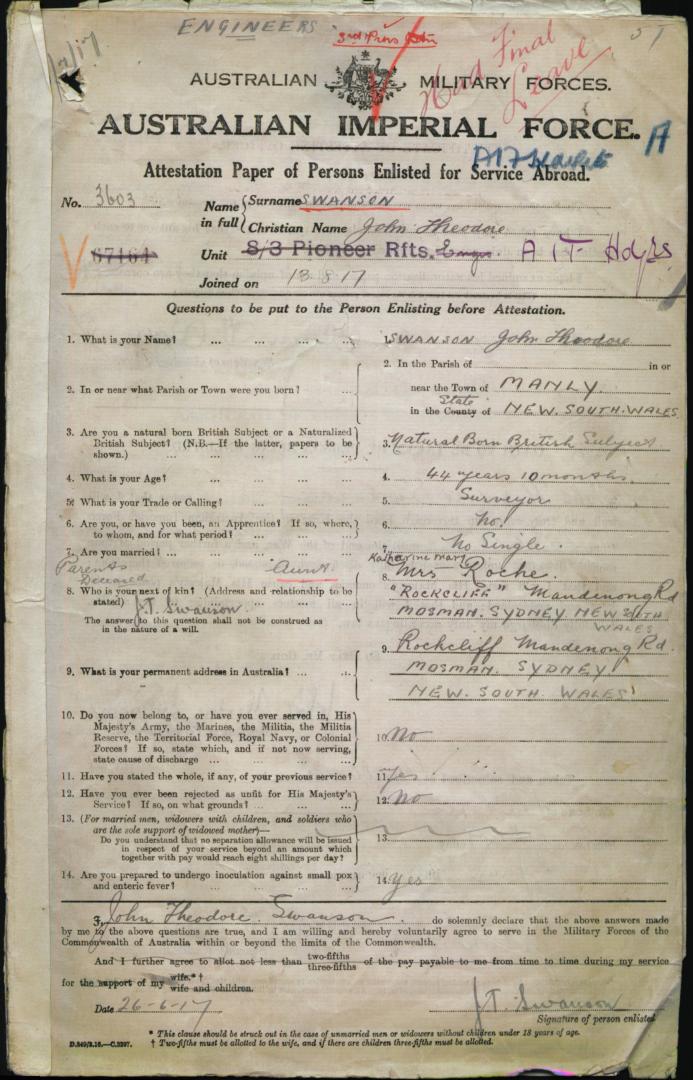
.jpg?timestamp=1420859545469) Bayview is steadily rising in Importance. Thousands who visit the locality gush over its lovely scenery, and its residents regard it as one of the most favored spots on earth; and if any suggestion be made to the contrary, they are ready with numerous arguments to support that opinion. The present Government, acting upon the sagacious suggestion of the member for the district, Mr. Dugald Thomson, has caused, to be constructed there a new pier, which will be appreciated not only by the frequent callers who make the journey thither by water, and whose yachts, during the season lend an additional charm to the seascape, but by the settlers in the place, who receive and send away many tons of produce in the year. The official opening of the pier took place on Saturday, and a small party left Sydney in the early morning to take part in the proceedings. Among the visitors were: Messrs. Dugald Thomson, Millard, and Cohen, M.L.A., Dr. Cullen. M.L.C., the Mayor of Manly (Alderman Fletcher), the Mayor of North Sydney (Alderman Purves),and Alderman T. J. West (Mayor of Paddington). Although somewhat threatening in the early part of the day, there was no rain, for which the party appeared thankful. The journey over the road from Manly acted like a good tonic, and all were in good spirits when they arrived at Bayview, where they received a cordial welcome from Mr. P. T. Taylor, president of the local progress association, Mr. J. J. Roche, and other residents. After a pleasant chat about the weather, the fruit-producing powers of the district, the poultry, and such-like matters of importance, the visitors were conducted under a gaily-decorated arch down the approach to the wharf. The latter is strongly built, is 140ft long, and there is a good depth of water alongside. Mr. Thomson mounted a portion of a recently-discharged cargo, and was requested by Mr. Taylor to perform the interesting ceremony. In giving expression to that desire, Mr. Taylor intimated that the residents were very much indebted to the Minister for Works (Mr. O'Sullivan), and to Mr. Thomson, for the erection of the wharf. Successive Ministers had promised that it should be done before, but their promises had been of pie-crust frailty. However, when the Minister visited the place with the member for the district a little while ago, he was impressed with its necessity, and tenders were called a few weeks later. That, of course, spoke volumes for the energy of the present Government, and particularly for Mr. O'Sullivan. Mr. Thomson, in that spirit of modesty which becomes a member of Parliament so well, declined to take all the credit for the work. 'There were,’ he said, ‘the strongest grounds for carrying it out Those of you who have been living here for so many years will remember the difficulties that have been experienced in landing goods. Men were obliged to wade through mud, and women and children to be carried. The work was certainly warranted. You will also remember that Mr. Roche, with commendable energy and enterprise, constructed a wharf himself, which the waves, with equal energy and enterprise, quickly destroyed, and it became necessary to have some better and more substantial means of approach. The Minister saw that necessity, and could not resist fulfilling his promise. I am glad you have the wharf, which will be of immense use to the district, and I hope that this ceremony will be a happy omen for the future. The ceremony over, the party boarded the steam launch Surprise, and were conveyed round Pittwater, and a delightful hour was spent viewing the glorious scenery which meets the eye on all sides. They were landed opposite the establishment of Mr. Buist, at which they enjoyed an excellent luncheon. The toast of 'The Queen' having been honored, Mr. L. Hopkins proposed the 'Ministry and Parliament.' In responding, Dr. Cullen referred to the importance of the Bayview district. Its claims would, he said, be recognised in the future, and, although they might have to wait for it, the tramway would come at last. With reference to the second Chamber of Parliament, the members of that body were abused and ridiculed a great deal; but they had to ask themselves if they had any business there unless they had to exercise their judgment upon the measures submitted to them —to act fairly and squarely to the whole of the people of the colony. He claimed that, with all its faults, the Legislative Council had tried to do so. He claimed that the second Chamber had rendered many services to the country during the present session. Over and over again the representatives of the other branch of the Legislature, who were elected by the people, were tempted by the least thoughtful to forget the duties, which they owed to the sober-minded, hard-working members of the community, who were not so well represented in the other Chamber; and measures that were passed by representatives who sat night and day needed the close attention of a revising Chamber. He appealed to the people of New South Wales to remember that while they had a second Chamber it was entitled to respect. If they did not respect it, let them sweep it out of existence at once. Although he was not in favor of a nominee Chamber, with life tenure, still that was better than having only one Chamber, but if it was not worthy of respect it should not be there. If the people wished for faithful service, and a court of appeal that would try fairly and squarely to serve the interests, not of any one class, but of the whole population, let them show the press of the country that they respected the Legislative Council and appreciated the work of its members. Mr. Millard, M.L.A, also responded. Mr. Cohen, M.L.A., proposed 'Success to the District,' and during his remarks made reference to the fact that its member would be a candidate for a seat in the Federal Parliament, expressing a hope that he would be found among its members. Mr. Purves supported the toast, and in doing so said he believed it was the Minister's intention to construct a tram line from Manly to Bayview. The toast was also responded to by Messrs, Taylor, J. Symonds (hon. sec), and Joseph Waterhouse. Mr. W. H. Vivian proposed 'The Member for the District,' which was cordially honored. Mr. Thomson spoke at some length in reply. Mr. C. Bennett proposed 'The Visitors,' which was responded to by Alderman Fleischer and Alderman West. A VISIT TO BAYVIEW. (1900, December 3). Evening News(Sydney, NSW : 1869 - 1931), p. 4. Retrieved from http://nla.gov.au/nla.news-article114014867
Bayview is steadily rising in Importance. Thousands who visit the locality gush over its lovely scenery, and its residents regard it as one of the most favored spots on earth; and if any suggestion be made to the contrary, they are ready with numerous arguments to support that opinion. The present Government, acting upon the sagacious suggestion of the member for the district, Mr. Dugald Thomson, has caused, to be constructed there a new pier, which will be appreciated not only by the frequent callers who make the journey thither by water, and whose yachts, during the season lend an additional charm to the seascape, but by the settlers in the place, who receive and send away many tons of produce in the year. The official opening of the pier took place on Saturday, and a small party left Sydney in the early morning to take part in the proceedings. Among the visitors were: Messrs. Dugald Thomson, Millard, and Cohen, M.L.A., Dr. Cullen. M.L.C., the Mayor of Manly (Alderman Fletcher), the Mayor of North Sydney (Alderman Purves),and Alderman T. J. West (Mayor of Paddington). Although somewhat threatening in the early part of the day, there was no rain, for which the party appeared thankful. The journey over the road from Manly acted like a good tonic, and all were in good spirits when they arrived at Bayview, where they received a cordial welcome from Mr. P. T. Taylor, president of the local progress association, Mr. J. J. Roche, and other residents. After a pleasant chat about the weather, the fruit-producing powers of the district, the poultry, and such-like matters of importance, the visitors were conducted under a gaily-decorated arch down the approach to the wharf. The latter is strongly built, is 140ft long, and there is a good depth of water alongside. Mr. Thomson mounted a portion of a recently-discharged cargo, and was requested by Mr. Taylor to perform the interesting ceremony. In giving expression to that desire, Mr. Taylor intimated that the residents were very much indebted to the Minister for Works (Mr. O'Sullivan), and to Mr. Thomson, for the erection of the wharf. Successive Ministers had promised that it should be done before, but their promises had been of pie-crust frailty. However, when the Minister visited the place with the member for the district a little while ago, he was impressed with its necessity, and tenders were called a few weeks later. That, of course, spoke volumes for the energy of the present Government, and particularly for Mr. O'Sullivan. Mr. Thomson, in that spirit of modesty which becomes a member of Parliament so well, declined to take all the credit for the work. 'There were,’ he said, ‘the strongest grounds for carrying it out Those of you who have been living here for so many years will remember the difficulties that have been experienced in landing goods. Men were obliged to wade through mud, and women and children to be carried. The work was certainly warranted. You will also remember that Mr. Roche, with commendable energy and enterprise, constructed a wharf himself, which the waves, with equal energy and enterprise, quickly destroyed, and it became necessary to have some better and more substantial means of approach. The Minister saw that necessity, and could not resist fulfilling his promise. I am glad you have the wharf, which will be of immense use to the district, and I hope that this ceremony will be a happy omen for the future. The ceremony over, the party boarded the steam launch Surprise, and were conveyed round Pittwater, and a delightful hour was spent viewing the glorious scenery which meets the eye on all sides. They were landed opposite the establishment of Mr. Buist, at which they enjoyed an excellent luncheon. The toast of 'The Queen' having been honored, Mr. L. Hopkins proposed the 'Ministry and Parliament.' In responding, Dr. Cullen referred to the importance of the Bayview district. Its claims would, he said, be recognised in the future, and, although they might have to wait for it, the tramway would come at last. With reference to the second Chamber of Parliament, the members of that body were abused and ridiculed a great deal; but they had to ask themselves if they had any business there unless they had to exercise their judgment upon the measures submitted to them —to act fairly and squarely to the whole of the people of the colony. He claimed that, with all its faults, the Legislative Council had tried to do so. He claimed that the second Chamber had rendered many services to the country during the present session. Over and over again the representatives of the other branch of the Legislature, who were elected by the people, were tempted by the least thoughtful to forget the duties, which they owed to the sober-minded, hard-working members of the community, who were not so well represented in the other Chamber; and measures that were passed by representatives who sat night and day needed the close attention of a revising Chamber. He appealed to the people of New South Wales to remember that while they had a second Chamber it was entitled to respect. If they did not respect it, let them sweep it out of existence at once. Although he was not in favor of a nominee Chamber, with life tenure, still that was better than having only one Chamber, but if it was not worthy of respect it should not be there. If the people wished for faithful service, and a court of appeal that would try fairly and squarely to serve the interests, not of any one class, but of the whole population, let them show the press of the country that they respected the Legislative Council and appreciated the work of its members. Mr. Millard, M.L.A, also responded. Mr. Cohen, M.L.A., proposed 'Success to the District,' and during his remarks made reference to the fact that its member would be a candidate for a seat in the Federal Parliament, expressing a hope that he would be found among its members. Mr. Purves supported the toast, and in doing so said he believed it was the Minister's intention to construct a tram line from Manly to Bayview. The toast was also responded to by Messrs, Taylor, J. Symonds (hon. sec), and Joseph Waterhouse. Mr. W. H. Vivian proposed 'The Member for the District,' which was cordially honored. Mr. Thomson spoke at some length in reply. Mr. C. Bennett proposed 'The Visitors,' which was responded to by Alderman Fleischer and Alderman West. A VISIT TO BAYVIEW. (1900, December 3). Evening News(Sydney, NSW : 1869 - 1931), p. 4. Retrieved from http://nla.gov.au/nla.news-article114014867 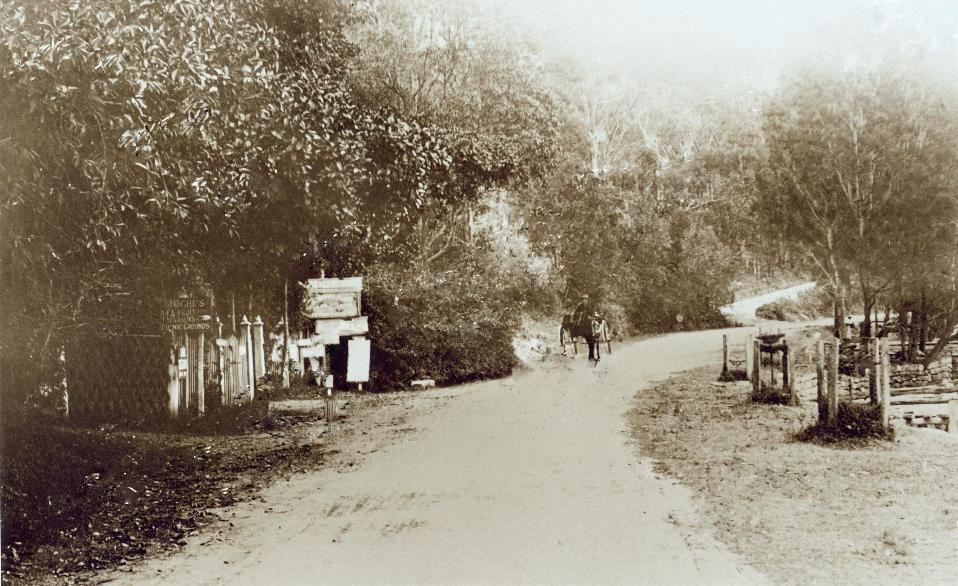
Roche's Corner, Bayview Wharf, circa 1900-1910
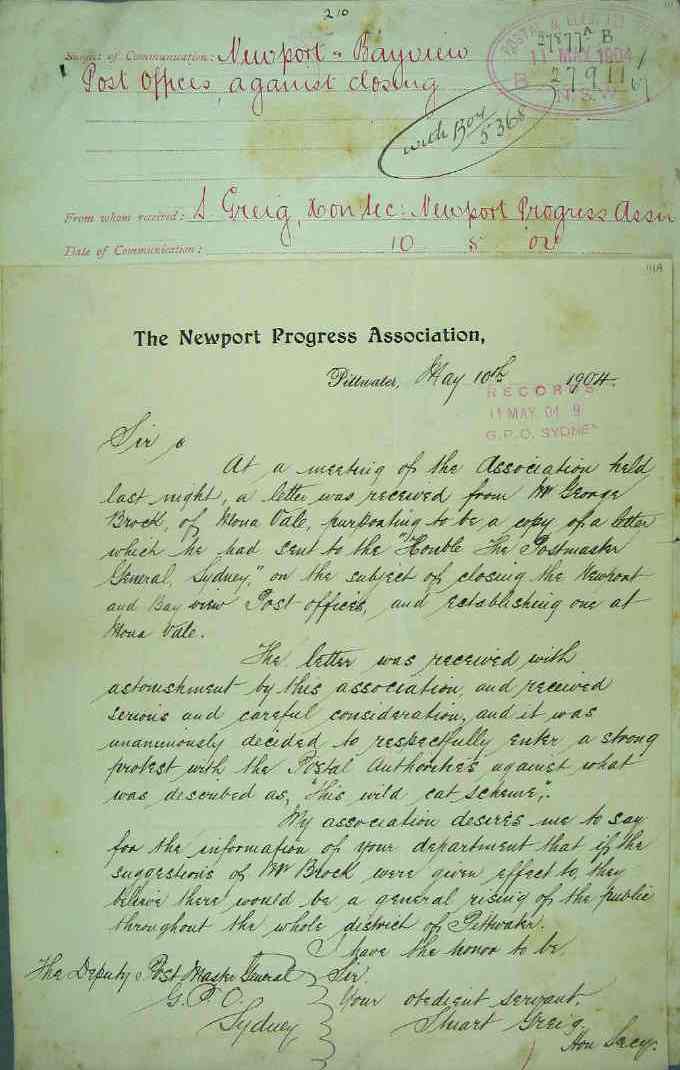
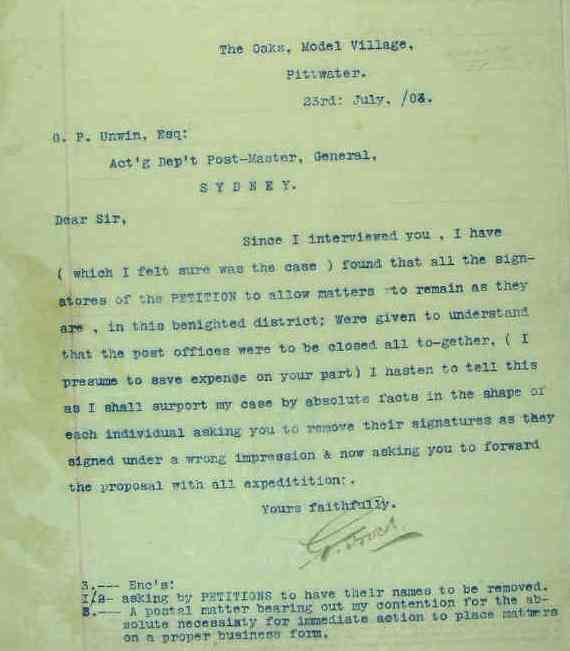
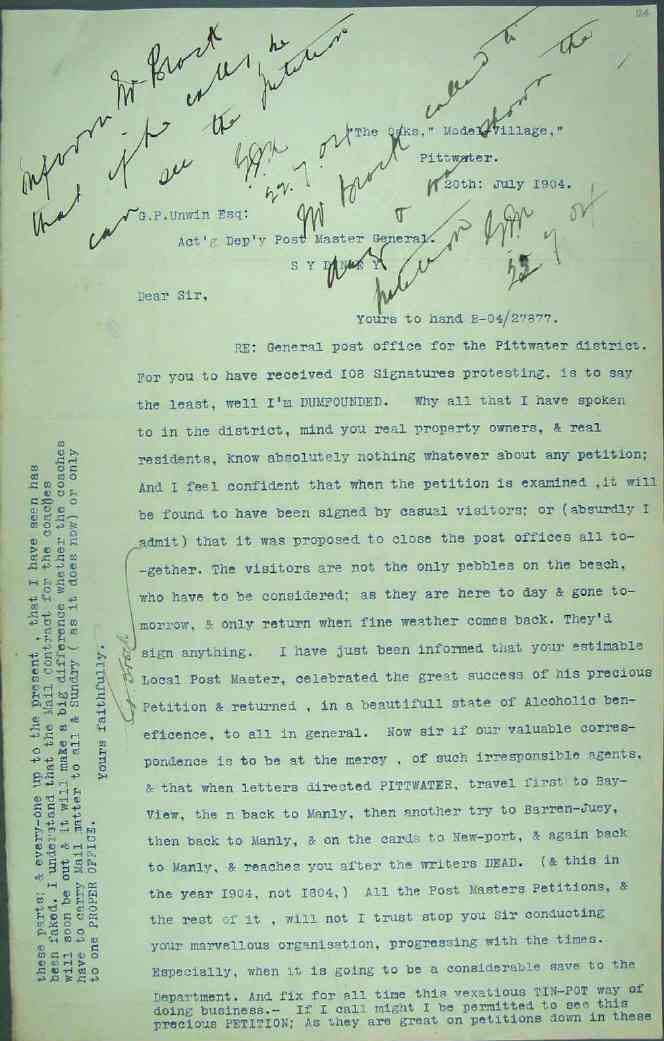
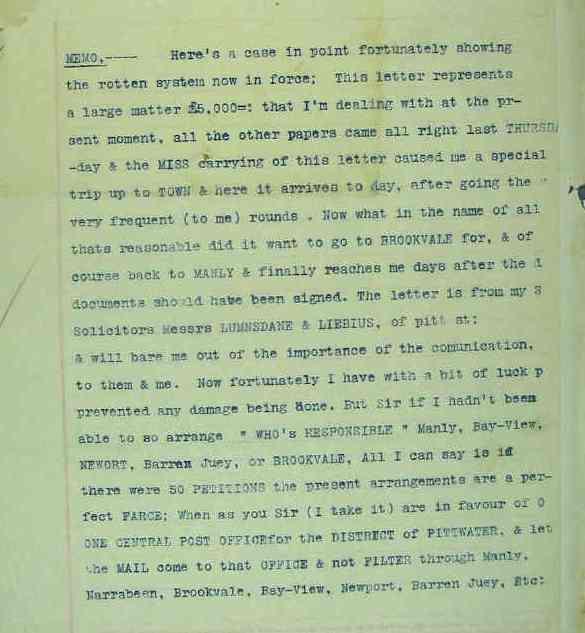
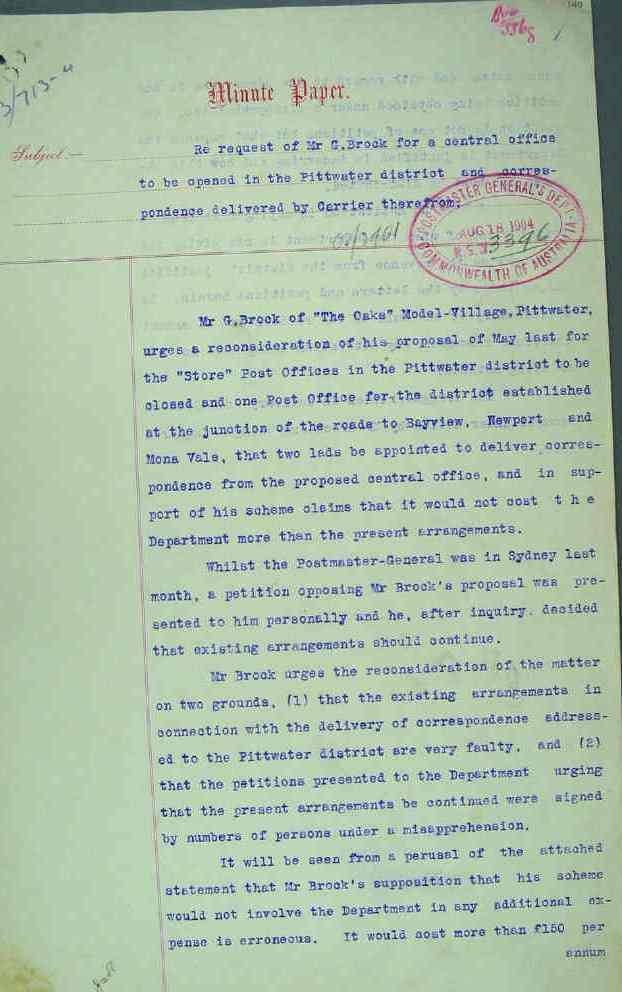
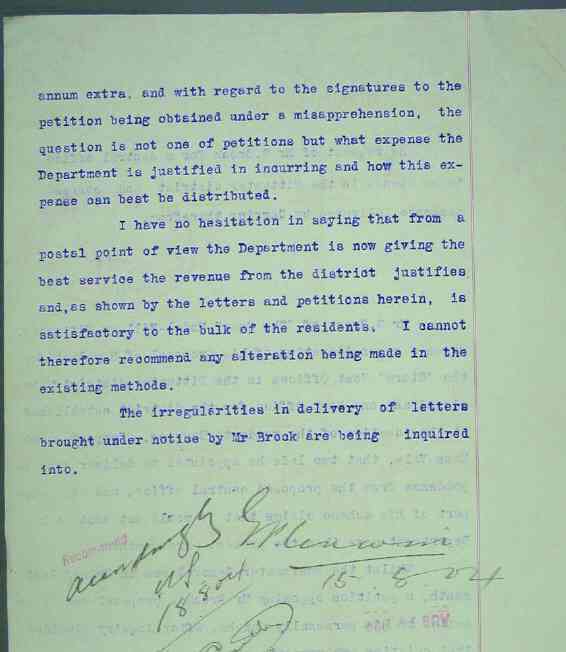
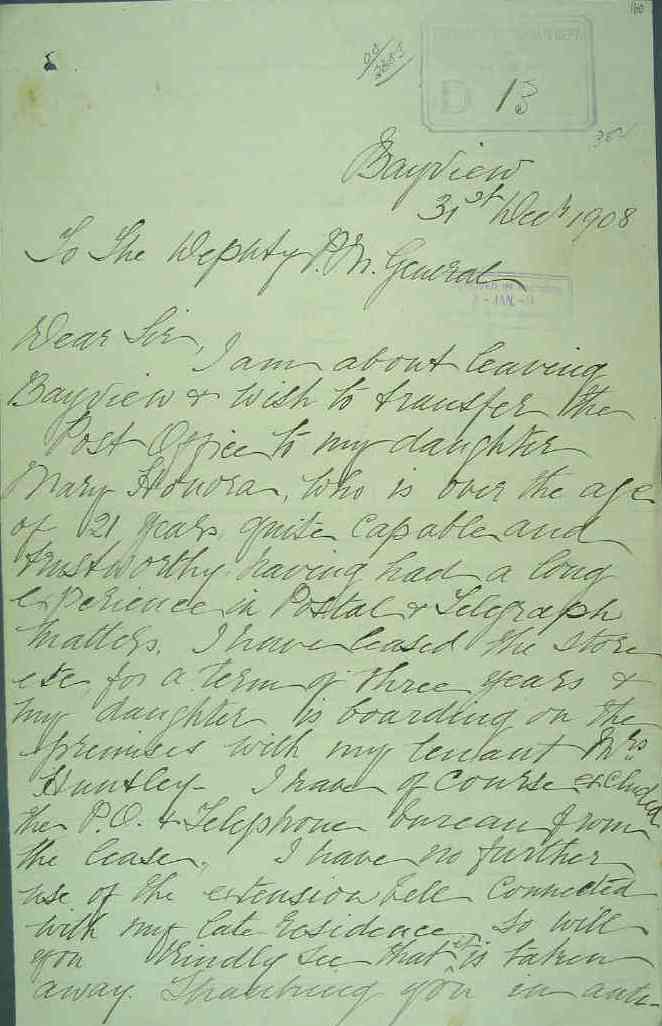
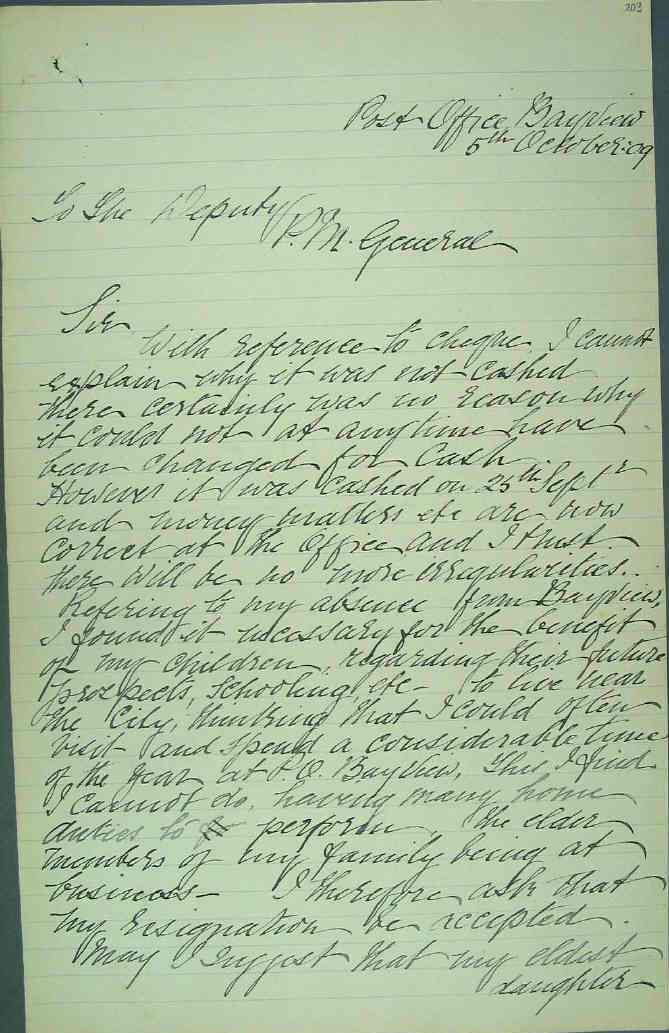 One of the early 'treatments' for those suffering pain from the debilitating polio disease was massage.
One of the early 'treatments' for those suffering pain from the debilitating polio disease was massage.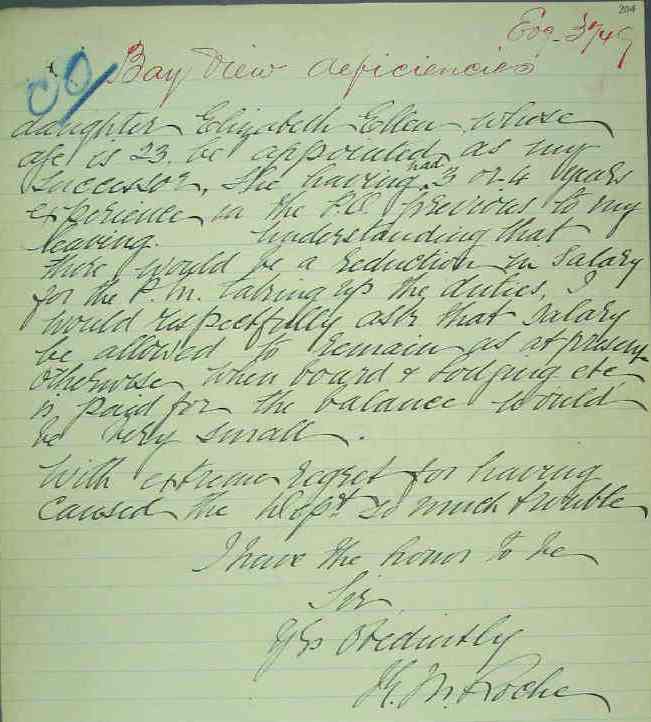 MOSMAN, "ROCKCLIFFE," MANDALONG-ROAD, corner Arbutus-street,-2-story Brick Residence, tile roof, containing porch entrance, drawing-room, dining-room, 2 bedrooms, bathroom (heater), kitchen, and laundry, and 2 bedrooms and sleeping-out verandah upstairs. Electric light. LAND 117ft 81n to Mandalong-road, with a depth along Arbutus-street of 110ft 6 ½ in. TORRENS TITLE. Advertising. (1926, May 25). The Sydney Morning Herald (NSW : 1842 - 1954), p. 4. Retrieved from http://nla.gov.au/nla.news-article16294044
MOSMAN, "ROCKCLIFFE," MANDALONG-ROAD, corner Arbutus-street,-2-story Brick Residence, tile roof, containing porch entrance, drawing-room, dining-room, 2 bedrooms, bathroom (heater), kitchen, and laundry, and 2 bedrooms and sleeping-out verandah upstairs. Electric light. LAND 117ft 81n to Mandalong-road, with a depth along Arbutus-street of 110ft 6 ½ in. TORRENS TITLE. Advertising. (1926, May 25). The Sydney Morning Herald (NSW : 1842 - 1954), p. 4. Retrieved from http://nla.gov.au/nla.news-article16294044 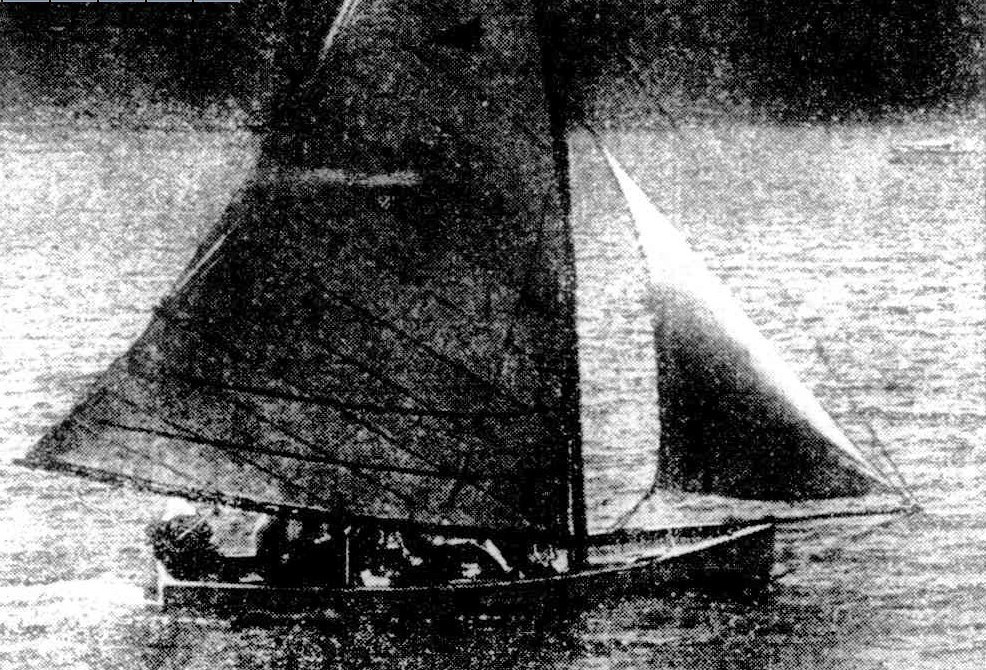
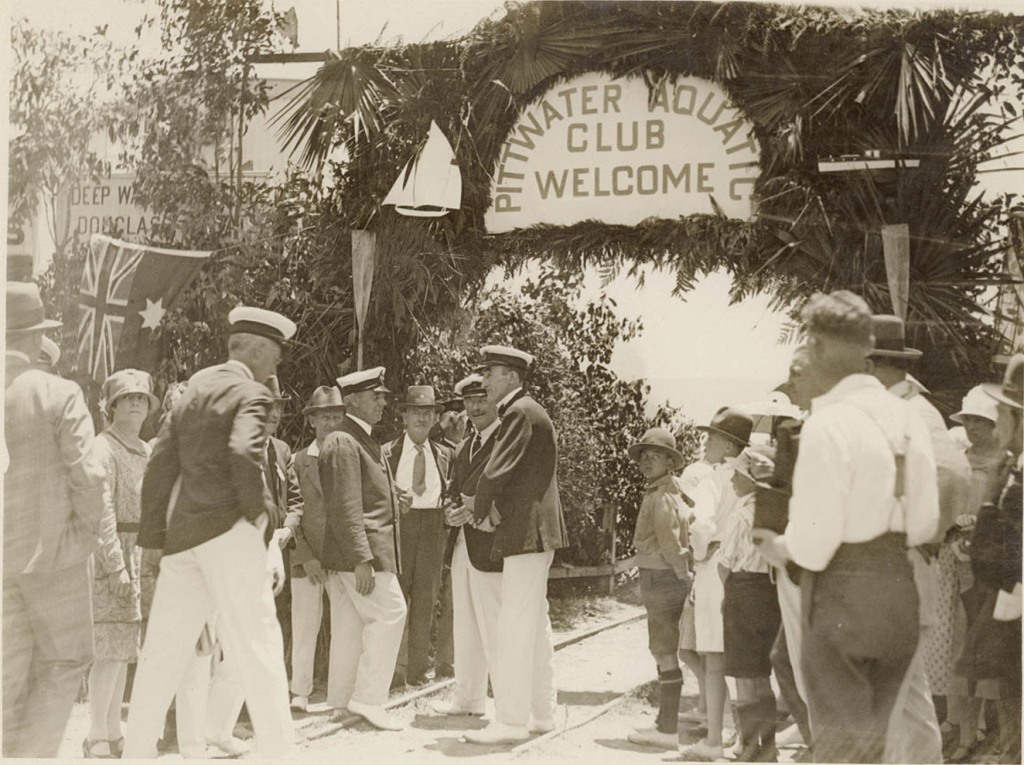
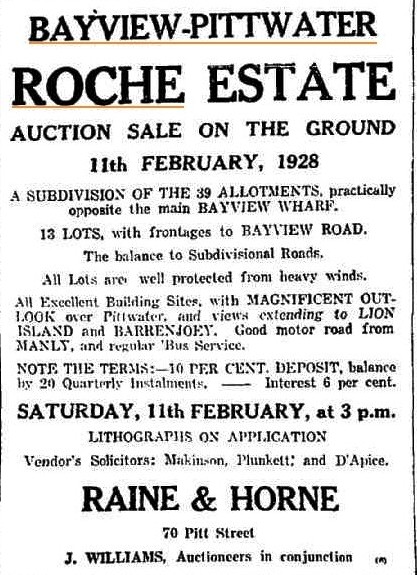 There was a large attendance at the annual dinner held In the evening at the Newport Hotel. The commodore (Mr. C. A. Le Maistre Walker, C.B.E.), in proposing the toast "The Day we Celebrate," said that Saturday was unique In the history of Pittwater Regatta. They had celebrated their 21st birthday, and for the first time the Governor-General had been their guest. In one race two boats had been sailed by father and son. Lord Stonehaven was so pleased with the victory of the Norn, formerly owned by Lord Forster, that he expressed the Intention of Immediately cabling the result to Lord Forster. (Cheers.) Pitt-water Regatta had made a name for Itself, of which It could rightly be proud, not only In the aquatic world of Australia, but throughout the British Empire.
There was a large attendance at the annual dinner held In the evening at the Newport Hotel. The commodore (Mr. C. A. Le Maistre Walker, C.B.E.), in proposing the toast "The Day we Celebrate," said that Saturday was unique In the history of Pittwater Regatta. They had celebrated their 21st birthday, and for the first time the Governor-General had been their guest. In one race two boats had been sailed by father and son. Lord Stonehaven was so pleased with the victory of the Norn, formerly owned by Lord Forster, that he expressed the Intention of Immediately cabling the result to Lord Forster. (Cheers.) Pitt-water Regatta had made a name for Itself, of which It could rightly be proud, not only In the aquatic world of Australia, but throughout the British Empire.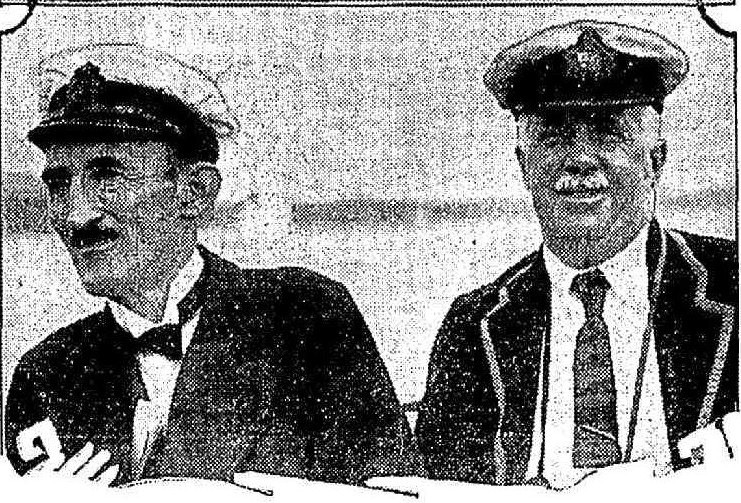
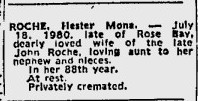 MR. J. ROCHE. The funeral of Mr John Roche, formerly of Balfour-road, Rose Bay, who was prominent In aquatic circles, took place to South Head cemetery on Saturday, after a service at St Mary Magdalene Roman Catholic Church, Rose Bay. The chief mourners were the Misses K and N Roche (sisters) Mr F Roche (brother) and Messrs J Robinson and M Palmer (brothers-in-law).
MR. J. ROCHE. The funeral of Mr John Roche, formerly of Balfour-road, Rose Bay, who was prominent In aquatic circles, took place to South Head cemetery on Saturday, after a service at St Mary Magdalene Roman Catholic Church, Rose Bay. The chief mourners were the Misses K and N Roche (sisters) Mr F Roche (brother) and Messrs J Robinson and M Palmer (brothers-in-law).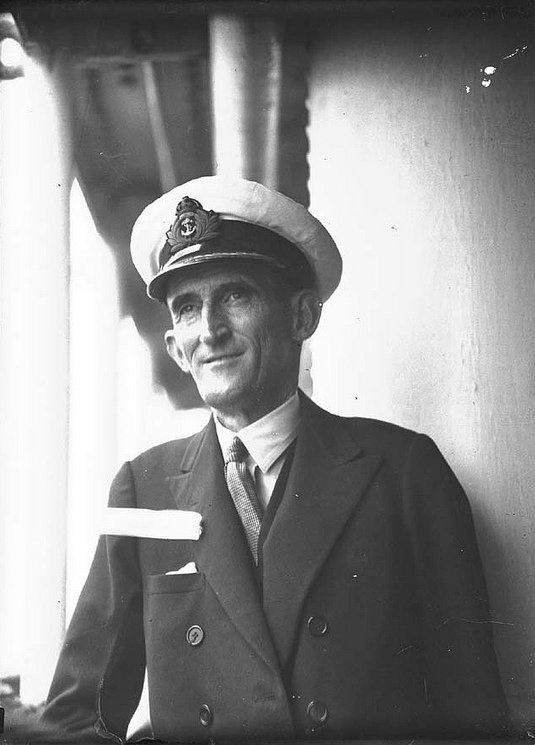 AN APPRECIATION. The 'Late' John Roche. (BY. R.S.S.)
AN APPRECIATION. The 'Late' John Roche. (BY. R.S.S.)
In the experience of everybody, we come across personalities which attract us, for reasons which often are somewhat hard to define-or, on the contrary, for outstanding qualities, which those who run may read, or, indeed, for some special act of public usefulness, or private unselfishness.
From whatever reason, or from whatever combination of them, John Roche, who died last week, was certainly one of those rare souls, who unconsciously, and without effort, gained among his fellows, their affection and confidence. It was just his cheerfulness, his placid courage, his elan, and fine conduct of life, which, in his case, had been, in many ways, no easy one.
Roche was brought up, from his earliest years, on a property on the estuary of the Hawkesbury, owned by his family at Bay View. We all, in our hearts, cherish some spot of this attractive, if difficult world, which we call home, and to which, as poets so often remind us, our wandering thoughts return. John Roche's mind, I do believe, was never far divorced from his beloved Broken Bay. He knew and loved every arm of its far-flung waterways, and he used to dwell with pride on the lush and often exotic vegetation that hid itself, and flourished, in sheltered spots round the creeks of that delectable region.
It followed that he not only liked the trees and fruits of his native bushland, but it was the sea that mostly called him, and so fishing and boats and yachts, or indeed anything that would carry him on the face of the waters, gave him a joy which never paled-a Joy happily shared by many of us who have escaped the devastating malady of golf or other things even less laudable!
But, apart from the prominent positions he has held in the yachting world, and which, Indeed, have been very useful, Important, and unselfish ones in all ways, and about which others are very much more competent to speak than I am-it is rather concerning his character as a man that I would wish to add my little offering to his name and fame.
It was probably known to all who knew him intimately, that from his childhood, he suffered from the after-results of that tragic malady of early life, Infantile paralysis. Most men would have wilted under such a handicap. Not so John Roche-neither in deed, manner, nor word did he allow his disabilities to alter his way of life. Nor did he ever pour out useless complaints against fate regarding his own great physical drawbacks. Far otherwise was his way, for he always carried a high heart, with a happy smile, and a wholesome speech to sweeten the day's greeting.
I might write much, and with more detail, of this line man's fine record, but it is not necessary, for of those who read tills small eloge of mine, who knew him, they could themselves tell much more of things Indicative of his life-long courage in the face of many difficult, days. We part indeed from "a very gallant gentleman," and a fine sportsman. AN APPRECIATION. (1936, October 20). The Sydney Morning Herald(NSW : 1842 - 1954), p. 10. Retrieved from http://nla.gov.au/nla.news-article17268893 Portrait of a Mr John Roche courtesy ANMM, Object no. 00024319.
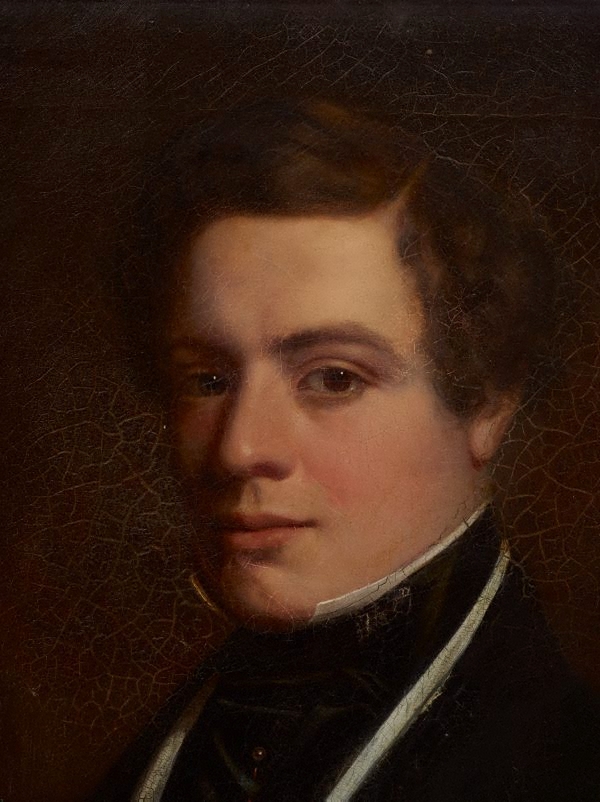 Dr R. Scot Skirving and wife Lucy (nee Hester) lost a child in infancy, another son died serving in WWI. A physician and surgeon, he was born on 18 December 1859 at Camptown, Haddington, East Lothian, Scotland, son of Robert Scot Skirving, farmer, and his wife Elizabeth (Leila), daughter of William Owen, squire of Ekindale, Rathdownie, Ireland. Among his forbears were Adam Skirving, poet, Archibald Skirving, painter, and 'Black' John Skirving who escaped from Flodden Field with the standard wrapped around his body and took it safely to Edinburgh. Reared in an atmosphere of extreme Calvinism, Robert attended the Edinburgh Academy and Eastman's Royal Naval Academy, near Portsmouth, England. A few weeks too old for the Royal Navy, he entered the merchant service and, after two voyages to Iceland, joined the training ship Conway, and was apprenticed in 1875 in a sailing vessel, Tantallon Castle, bound for Port Adelaide.
Dr R. Scot Skirving and wife Lucy (nee Hester) lost a child in infancy, another son died serving in WWI. A physician and surgeon, he was born on 18 December 1859 at Camptown, Haddington, East Lothian, Scotland, son of Robert Scot Skirving, farmer, and his wife Elizabeth (Leila), daughter of William Owen, squire of Ekindale, Rathdownie, Ireland. Among his forbears were Adam Skirving, poet, Archibald Skirving, painter, and 'Black' John Skirving who escaped from Flodden Field with the standard wrapped around his body and took it safely to Edinburgh. Reared in an atmosphere of extreme Calvinism, Robert attended the Edinburgh Academy and Eastman's Royal Naval Academy, near Portsmouth, England. A few weeks too old for the Royal Navy, he entered the merchant service and, after two voyages to Iceland, joined the training ship Conway, and was apprenticed in 1875 in a sailing vessel, Tantallon Castle, bound for Port Adelaide.
On the return voyage Scot Skirving developed beri-beri, which led him in 1876 to enrol in medicine at the University of Edinburgh (M.B., Ch.M., 1881). He came fifth in a year which also included (Sir) Alexander MacCormick, (Sir) Thomas Anderson Stuart and (Sir) Arthur Conan Doyle. After further studies in Dublin and Vienna he was appointed house physician at the Royal Infirmary, Edinburgh, in 1881. Early in 1883 Scot Skirving joined the migrant ship, Ellora, as ship's surgeon and returned to Australia. He practised in Queensland until appointed medical superintendent at (Royal) Prince Alfred Hospital, Sydney, by Anderson Stuart in November 1883. In 1884 he set up practice in College Street and on 6 January 1886 at Willoughby married Lucy Susan Hester (d.1950).
Right: R. Scot Skirving portrait, courtesy State Library of NSW - now held by Art Gallery of NSW - Gift of R.C. Scott 1956
He was successively honorary assistant physician (1884-89), honorary physician (1889-1911) and consultant from 1911 at R.P.A.H. As honorary physician at the Hospital for Sick Children (1884-89) he clashed with its lady superintendent, Frances Holden. He was also an able surgeon and was honorary surgeon at St Vincent's Hospital (1889-1923). He was the lecturer in clinical medicine at the University of Sydney (1889-1911), was president of the New South Wales branch of the British Medical Association (1891-92) and served as chief medical adviser to the Australian Mutual Provident Society (1911-36). During World War II he was persuaded by (Sir) Herbert Schlink to lecture at R.P.A.H.
As a clinician Scot Skirving was greatly celebrated. A handsome man, about 5 ft 10 ins (178 cm) tall, with aquiline features, he was a popular teacher and an accomplished, if somewhat flamboyant, lecturer, illustrating his points with amusing anecdotes. He served in the South African War as consulting surgeon (1900-01) with MacCormick and on his return wrote a pamphlet on Our Army in South Africa (1901). In England on the outbreak of World War I, Scot Skirving served as a major in the Royal Army Medical Corps, for three months in charge of an auxiliary hospital in Essex, then as surgeon specialist at Queen Alexandra Military Hospital, Millbank, London. In 1918 he reported on Australian medical units in northern France, at the request of Major General Sir Neville Howse. He returned to Sydney in January 1919.
Scot Skirving published extensively on medical and more general subjects in the Australian Medical Gazette and the Medical Journal of Australia, including his reminiscences of his voyages to Australia. Widely read, with a poetic turn of phrase and an evident love of the English language, he entertained Robert Louis Stevenson (whose works he admired) and wrote a novel, Love and Longitude (1901). His speech, uttered in a deep, rich voice, reflected both the Bible and his saltier experiences in the merchant marine. He became renowned for his biting comments about his colleagues. The sea remained 'his greatest love': he held a master's certificate, belonged to the League of Ancient Mariners of New South Wales, sailed his own yacht until his eighties, and in 1931 published a manual, Wire Splicing for Yachtsmen.
Even at the time it was rare for 'a man to practice as a specialist surgeon at one hospital and as a specialist physician at another'. He was proud to be a foundation fellow of both the (Royal) Australasian College of Surgeons (1927) and of the Royal Australasian College of Physicians (1938) and an honorary fellow of the Royal College of Surgeons, England (1953). Scot Skirving died at his Bellevue Hill home on 15 July 1956 and was cremated. He was survived by one of his three sons: one had died in infancy and Archibald was mortally wounded in 1915 at Gallipoli while serving with the Royal Irish Fusiliers. Scot Skirving's estate was valued for probate at £213,817 in two States. His name is commemorated at the University of Sydney by a prize in medicine and surgery.
%201909%20road%20to%20bayview.jpg?timestamp=1420892510549)
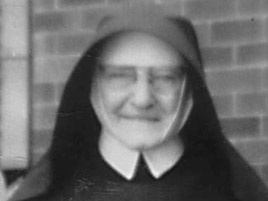 The new parish priest of Lakemba began to visit the people and after a while he asked Sister Shirley Fagan’s mother, who lived near the presbytery, ‘who is this Sister Campion? Everyone in the Parish talks about her?’ The following represents memories of some of the Sisters.
The new parish priest of Lakemba began to visit the people and after a while he asked Sister Shirley Fagan’s mother, who lived near the presbytery, ‘who is this Sister Campion? Everyone in the Parish talks about her?’ The following represents memories of some of the Sisters.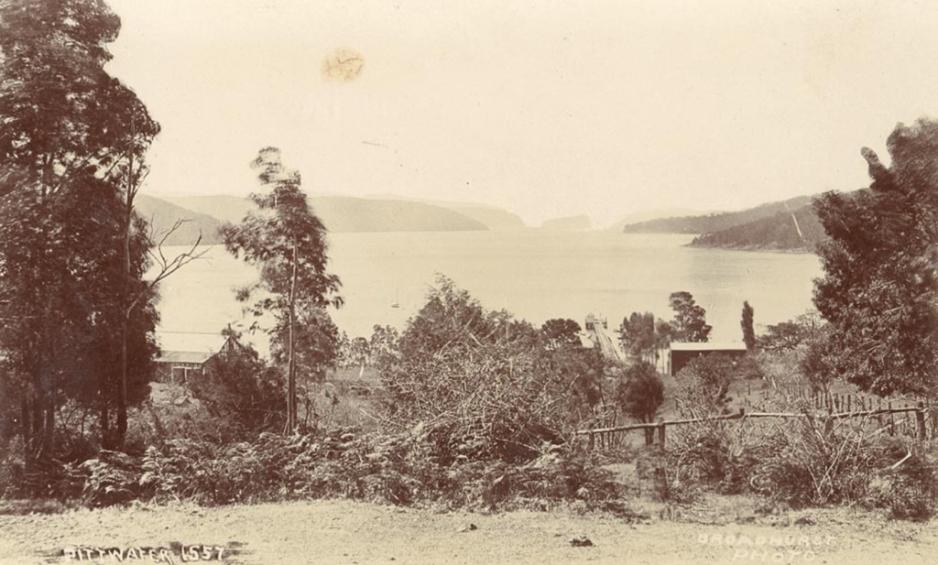
Above: The view down the hillto Barview Wharf - Roche premises to right, Maybanke Anderson home to left. Below: 'white paling fence'at front of Roche hoome and view to Bayviw wharf - both circa 1900-1910. Photos courtesy State Library of NSW images No: a106167h and a106165h
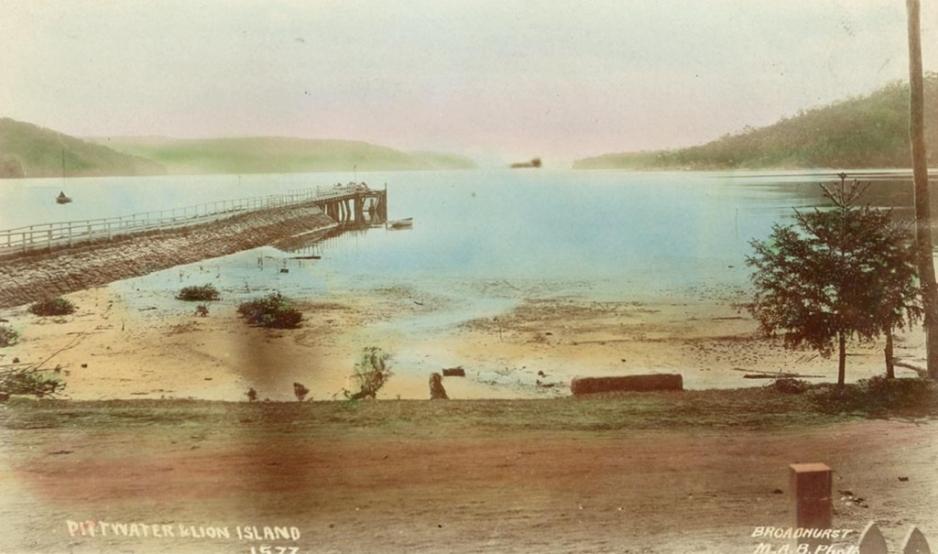
Extras:
Poultry-farming and Fruitgrowing at Pittwater.
By G. E.
Anyone with a day or two's leisure and a taste for picturesque scenery cannot do better than go over to Manly by steam boat and secure a seat in one of M. Houreaux's comfortable coaches which await the steamer's arrival at the pier to convey intending passengers to Rock Lily and Bayview, the former being about 10 and the latter 13 miles from Manly. The drive is one of the pleasantest and at the same time the least expensive to be had anywhere about Sydney, the fare to Rock Lily being only 1b and to the terminus at Pittwater a 6d extra. The views obtained from many points along the road are varied and charming. Now the coach sweeps by still waters embosomed in forest greenery; anon, as we approach nearer the coast, bold headlands are to be seen jutting out into the Pacific, with intervening stretches of sandy beach; on which the blue waves curl and break with a crisp and pleasant sound ; while the horizon seaward is fleered with many a sail or darkened by the smoke of passing steamers, and the foliage of the Banksias on the uplands swayed by the sea-breeze and glistening in the sun like burnished silver. All these objects, as they successfully come into view; combine to make our Journey anything but monotonous. Moreover, the lush Hinging the -roadside is rich in floral wealth, especially in the spring of the year, bright-hued flowers peeping form from every nook, and graceful eras displaying their green frondage on many a mossy bank. The air, too, is so delightfully pure and fragrant that it is a pleasure to inhale it after the fetid atmosphere of the city, and it has a way of its own in sharpening one's appetite to such a degree that we feel quite prepared, on reaching Rock Lily, to do justice to the good things provided for us by the host of the Rock Lily Hotel The menu is extensive and varied, quite equal to the best of our metropolitan cafes, find after luncheon there are quoits, skittles, Swings, and other aids to digestion, in the retention grounds over the way, to which most of the visitors make their way. But we are bound for Bayview, and Harry the driver's 'all aboard !' shortly summons as to mount the smaller vehicle, which has been put on to convey us to our destination.
There is nothing particularly attractive m the immediate surroundings of Rock Lily. The hotel stands on flat, low-lying ground, with a back ground to the westward of dark, forest covered hills. The landlord and his wife hail from La Belle France. He Is somewhat of an expert in the nee of the brush, and visitors to the hotel cannot fail to notice evidenoes of his skill in this direction in the numerous sketches which ornament the walls of the rooms. About ban a mile beyond Rock Lily the road leads between two stately columns of the Livistonia palm, and it is to be hoped that these beautiful specimens of a fast- disappearing and interesting class of plants may be long spared from destruction. After passing the little church the scenery becomes more picturesque as the coach winds round the foot of Roche's Hill On our right a dense belt of casuarina trees shuts us out from any extended view in that direction but; after reaching the point where this belt terminates, the beautiful expanse of water known as Pittwater comes suddenly into sight, with the village of Newport visible under the high land near the head of the inlet, Scotland Island over near its western shore, and Lion Island dimly outlined in the hazy distance. Pittwater is one of the southern branches of Broken Bay, and is bounded easterly by the long and narrow peninsula terminating in a point at Barrenjoey. Along its western shores extends the recently-proclaimed national park -known as Kurring-gai Chase.
Presently we reach the homestead of Mr. J. J. Roche, who, besides working an orchard and poultry-farm, keeps the local store and post-office. Here we alight to inspect the prize poultry of which Mr. Roche is so successful a breeder. The approach to his house, which stands on a gentle eminence, is by a road bordered with orange and lemon trees, in fall bearing and pictures of robust health. The proprietor, whom we surprise in the attending of work among his feathered flocks, greets us with a cordial welcome, and conducts us through his establishment, pointing out such birds as he considers worthy of special notice, whether on account of their value as layers or for table use. Each class has a separate shed and run to itself, and it is impossible with these precautions for any mixed strains to appear. The runs are severally enclosed by 6ft. wire netting affixed to hardwood standards, and each run is so arranged as to contain within its boundaries some shady fruit tree under which the fowls gather in the heat of the day. Langshans, white and brown Leghorns, and Minorcas are the principal breeds raised by Mr. Roche, and the stock at present on hand comprises about 600 head of all classes. Some of the birds are marvels of beauty and size, and the proprietor tells as that the demand for sets of eggs from his stock exceeds the supply.
After surveying the occupants of the various pens and the excellent appliances for closing the inlets to the sheds at night so as to secure the birds from the depredations of- native cats and other nocturnal prowlers, we stroll through the orchards and orangeries. Mr. Roche commenced about 12 years ago to clear his ground, which was then occupied by an primeval forest, and he has now got .. acres under fruit trees. The ground has a northerly aspect, and is sheltered from southerly and south easterly gales by a high ridge of forest-clad hills. Both soil and position are admirably adapted for the successful growing of citrus trees yielding immense crops of fruit of the finest quality. Five acres are devoted to oranges and 5 to lemons ; peaches occupy 3 acres, apricots 3, and other fruits, including plums, guavas, loquats, &c.,fiacres. The principal varieties of oranges grown are St. Michael's, navel, and proved seedlings.
About half a mile beyond Mr. Roche's, and nearer Church Point, is the orchard of Mr. J. R. Baker, comprising 6 acres of peaches, nectarines, and other summer fruits, and 2 acres of oranges, many of the latter when ripe measuring 18in. in circumference. Mr. Baker keeps about 100 head of poultry, chiefly crosses from Langshan, Leghorn, and Minorca stock. Half an hour's pleasant walk over the hill brings as to the snug little homestead of Mr. C. F. Munro, on a slope facing the south-east. He has been six years working up his selection to its present admirable condition, and has 8 acres of healthy. -looking fruit trees. He finds that the stone fruits do better on his ground than oranges, consequently the area devoted to the latter is limited in extent. About 100 head of poultry are kept, principally Minorcas, and a fine lot of birds they are. Mr. Monro is a bachelor, and does all his own work, both outside and in. He makes tea for us, and sets before us bottled fruits, jellies, and other delicacies prepared by his own hands from the products of his own land, and after tea lights his pipe and shows us a collection of native weapon brought by him from Northern Queensland. From the front of his house there is a pretty view across the valley to the sloping hills beyond, where a fine smoke wreath is seen curling upward from the bush, and which indicates the spot where an old friend of my own has purchased land and set himself the task of clearing the forest and planting a home in the wilderness. Poultry-farming and Fruitgrowing at Pittwater. (1895, March 2).The Sydney Mail and New South Wales Advertiser (NSW : 1871 - 1912), p. 424. Retrieved from http://nla.gov.au/nla.news-article162736592
Manly to Broken Bay. - A PICTURESQUE AND HEALTHY TRIP. BY "ST. MAGNUS."
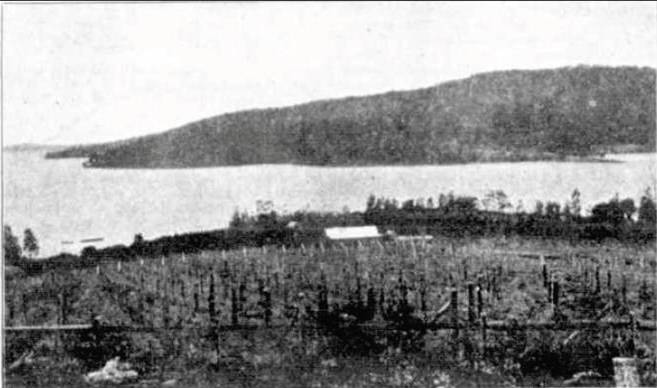
From Bay View the road, a very good one, winds around the beach, disclosing as every vantage point is gained new beauties of land and water. Around here are some very good orchards, with trees laden with fruit, and the homesteads peeping out from masses of evergreen foliage, with an extensive vista of land and water.
Our illustration, " A Cluster of Lemons," grown by Mr. Roche, on his Bay View Orchard, will compare favorably with any fruit of the kind grown in this country or any other. The lemons, which are of the Lisbon variety, and are very juicy, are simply superb, and grow close to the salt water in the greatest profusion ; and oranges, which are of the Siletta variety, are among the sweetest and best ever grown.
 On Mr. Roche's property are several small caves, interesting as the unmistakable residence of generations of blackfellows, and the shells and debris collected show ages of habitation, and what is now used as manure.
On Mr. Roche's property are several small caves, interesting as the unmistakable residence of generations of blackfellows, and the shells and debris collected show ages of habitation, and what is now used as manure.
The flora of the district is varied, as may be supposed from the climate and soil. Grey gum, spotted gum, ironbark, blood wood, and turpentines, and others of the eucalypti develop into lofty trees, which cover the whole face of the country and give it a densely wooded appearance. In the olden days large quantities of excellent timber was shipped from the district, and there is still large quantities obtainable, although not so handy as desirable. A dense undergrowth occurs in suitable situations, prominent among which are the numerous palms common to the coast. The baroneas, flannel flowers, waratahs, fuchsias, &c, all grow in the most bewildering confusion ; rock lilies, stag horns, and other epiphytal plants cover the rocks and trees, while a perfect maze of ferns cover the sward wherever they can find root for themselves, from the tender maidenhair to the more lofty fern tree. Ever-flowing streams of water pour down from the mountain sides, in some instances forming cascades of considerable volume, which still further enhance the beauty of the scene.
In short this favored region has every resource calculated to render it a fit habitation for man, a salubrious climate, fertile soil, plenty of wood and water, and within easy distance from market. Its fisheries alone, if energetically prosecuted ought to return a revenue sufficient to support a large population, while its close proximity to the metropolis and many beauties ought to attract a constant stream of tourists. The reason the district is so backward in respect of permanent settlement is no doubt because there are so many other localities where the land is more easily cleared and the soil of a better quality. One drawback has been that much of the best of the land has been locked up from settlement by large landholders. Tourists and summer visitors are now beginning to pour into the district. Many Sydney business men are buying properties and building cottages there on for summer residences. The district has rapid and efficient and cheap, communication with Manly, by coach, but what is required to bring it within easy reach of the metropolis is a tramway or light line of railway. Under existing circumstances one can leave Church Point at 6.15 a.m., and reach Circular Quay by the Manly boat at 9 a.m., but a railway to North Sydney would do the journey much quicker and with more comfort. As a place of resort for holiday-makers Pittwater and Broken Bay has many, attraction and as a place of residence for those who like marine views it stands unsurpassed. Manly to Broken Bay. (1893, November 11). Australian Town and Country Journal (NSW : 1870 - 1907), p. 19. Retrieved from http://nla.gov.au/nla.news-article71191632
The postponed Pittwater regatta will-be held tomorrow. The hon. secretaries (Miss Gladys Roche, and. Mr. J. Roche), and the committee have done a lot of work. Nearly a' hundred entries have been received for the various rowing, sailing and motor boat races. ' The first event is timed to start at -11 am and is for localboats 14ft to 18ft, for. which fifteen entries have been received. For the ali^comers' –sailing skiff : race the following are the handicaps :,—Native (H. Rodrick), scr; Dart (J. Sharp), 8min Rainbow (J. Hanson), 8min; Mat (W. Riddie),9min;..Rio- (A. Robey), 13min; Myrtle (J.Crouch), --.16min. The entries for the ladies' single sculls are:— Mrs. Wilmot, Mrs. Jackson, Miss G. Lloyd, and, Miss L. Arter. The other events: also include three in which ladies may join, and the sailing races cater for- all-classes of local craft. The steamer will be the flagship. Special coaches and motor 'buses'will leave Manly for Bay View wharf at 9.15, 10.15, and 11.16,'- returning immediately after the last race is completed. SAILING. (1907, March 22 Friday). Evening News (Sydney, NSW : 1869 - 1931), p. 2. Retrieved from http://nla.gov.au/nla.news-article115224482
SAILING. The Pittwater Regatta will be held on the16th instant The programme comprises fifteen rowing, sailing, and motor events The prize money totals £55, 10s, besides a number of trophies. There are three sailing events, open to all-comers, viz , Handicap for 16ft skiffs, under P.J.S.S.C. rules, prizes £7, £2, and £1;handicap for 14ft to 24ft boats f jib and mainsail only), prizes £5, £2, and trophy; and an all boats' handicap (jib and mainsail only, to be sailed by youths under 18), prizes £2 and £1.There is also a licensed fishing boat handicap-jib and mainsail) for Broken Bay, Hawkesbury, Cowan, and Brisbane Water boats, tor prizes of£6, £1, and trophy. The rowing portion. includes three races for ladies, and one for ladies and gentlemen, these, as -well as other -events, being for local residents only Entries for all comers' races will close on the 12th, the local events closing tin the 9th. Miss Gladys Lloyd and Mr- -John Roche are the hon. secs, their address being Post Office, Bay View, Pittwater. The flagship will be the steamer Woy Woy. SAILING. (1907, March 9). Evening News (Sydney, NSW : 1869 - 1931), p. 7. Retrieved from http://nla.gov.au/nla.news-article115223002
Third Heat. Misses Gladys and Hilda Lloyd.-Manly (all white); Misses Ruby and Jessie Bouchior, Port Hacking (red, white; arid blue) ;Misses Edith and Mabel Herbert, Port Macquarie (gold' sashes' and caps) ; Mrs. S. Green and Mrs. Young, Darlinghurst (blue and gold)ROWING. (1906, August 1). Referee (Sydney, NSW : 1886 - 1939), p. 9. Retrieved from http://nla.gov.au/nla.news-article120320982
On March 12 the marriage of Mr. Leslie Fortnam Glen, oldest son of Mr. A. W. Glen, of Manly, with Miss Amy Muriel Lloyd, second daughter of Mr. W. F. Lloyd, of Pittwater, took place In the Presbyterian Church, Manly. The ceremony was performed by the Rev. Anderson Gardiner in the presence of a large number of relations and friends. The church was prettily decorated for the occasion by girlfriends. The bride was given away by her father, and wore a dress of white voile, with white hat and veil of chiffon, and carried a bridal bouquet with satin streamers, the gift of an old and valued friend. The bridesmaids were Miss Gladys Lloyd and Miss Emma Glen, both of whom wore white silk, with hats to match. They also wore a gold ring and watch respectively, the gifts of the bridegroom. Mr. S. Williams acted as best man. After the ceremony a reception was held at Purves, Manly, where a large number of wedding guests were received and entertained with light refreshments. The happy pair drove away about 5 o'clock amidst showers of confetti and flowers for their honeymoon, which Is to be spent on the Wrestern Uno. Amongst the invited guests were:-Mr. and Mrs. W. F. Lloyd, Mr. and Mrs. A. W. Glen, Miss Gravely, Miss M. Lloyd, Mr. and Mrs. D. R. Muir, Miss Florence Muir, Mr. and Miss Lloyd, Mr. and Mrs. E. Poulton, Miss H. Lloyd, Miss G. Lloyd, Mr. and Mrs. Williams, Master S. Lloyd, Mr. and Mrs. Morgan, Miss L. Glen, Miss E. Glen, Miss A. Glen, Mr. H. Glen, Mr. and Mrs. Lawson, Mr. and Mrs. MacKenzie, Mrs. Williams, Mrs. Urquhart, Mrs. Smith, Miss F. Smith, the Rev. Anderson Gardiner and Mrs. Gardiner Mr., Mrs., and Miss Burge, Mr. and Mrs. Williamson, Mr., Mrs., and Miss Lackey, Mr.S. Lackey, Mr., Mrs., and the Misses Allen, Miss L Beaver, Miss A. Beaver, Mrs. and Miss Thomas, Mr. and Miss Shortus, Miss Green, Mrs. and Miss Gant, the Misses Hannam, Miss Nathan, Miss Morton, Miss D. Williams, the Misses MacKenzie, Mr. Middleton, Mr. Sid.Williams, Mr. Meyers, Mr. Cullen, Mr. H. Gordon, Mr. O'Grady. The presents were numerous and costly. SOCIAL. (1904, April 9). The Sydney Morning Herald (NSW : 1842 - 1954), p. 9. Retrieved from http://nla.gov.au/nla.news-article14612240
MR. W. F. LLOYD. Mr William Frederick Lloyd, whose death took place at his home in Pittwater last week, was a well-known resident of Manly and outlying districts for a quarter of a century. Born In Sydney eighty years ago, he was for many years in the service of Mr F Lassetter, of George-street He was one of the senior officers, when he retired to start a business for himself, as a commercial broker.His father, for a considerable period, was superintendent of the Government Dock at Cockatoo. The late Mr Lloyd, was a nephew of the late Mr George Alfred Lloyd of Elizabeth Bay The deceased was a keen cricketer in his younger days and always a most enthusiastic fisherman. MR. W. F. LLOYD. (1927, May 24). The Sydney Morning Herald(NSW : 1842 - 1954), p. 12. Retrieved fromhttp://nla.gov.au/nla.news-article1637532
MANLY REGATTA : AN IMMENSE SUCCESS Boomerang Wins Barton Smith Cup Sunbeam Scores: Interstate Racing
(By PELORUS)
Lulled by breezes serene and tender,
Set by surges and snow-white sands,
Crowned with beauty and clad in splendor,
Matchless Manly for ever stands. — Roderic Quinn.
Manly Cove fairly scintillated in the glorious sunshine during the holding of the regatta, making a charming setting for the numerous white-sailed craft afloat, and the splashes of many-colored bunting that marked the occasion. The event of last week-end was Manly regatta, which, in the perfect weather that prevailed, was, from every point of view, an immense success. The threatening clouds of the morning made way for radiant sunshine,, and this, with refreshing tops'l breeze from the northeast, which, whilst being quite sufficient for the sailing events, did not interfere with the rowing races, made the conditions excellent. The flagship, the Port Jackson Company's s.s. Bingarra, after picking up the president and officials and a number of spectators at the Manly wharf, proceeded to moorings in North Harbor, inside the reef at the point, and in a straight line -with the jetty, a position commanding a full view of the rowing courses and a fair portion of the sailing arena. No wonder there was a largeattendance.
CHARMING SCENE.
After 2 p.m., when boats of many kinds— from Lilliputian dinghies to 10-metre yachts — from the harbor bays assembled, and subsequently during the contests, the waters of Manly Cove and North Harbor presented a scene abounding in charm and absorbing in interest. Like Pittwater, Manly possesses all the facilities for a regatta. The president of the regatta, Mr. F.E. Barton Smith; Mr. L. H. Simms, the secretary; the executive committee; and Mr. John Roche, the unofficial counsellor, are to be congratulated upon the general arrangements, the provisions for the convenience and comfort of the public, the care with which the marks were laid; the elegant and well printed programmes, and the splendid manner in which everything was carried out. There was not a hitch. It is surely an achievement to conduct a regatta of sixteen events in an afternoon of little more than three hours, as was the case at Manly, with a precision and smoothness from start to finish that never for one moment faltered.
ON THE BINGARRA.
For the throng on the flagship there was amusement and excitement. Some of the finishes were very close, and, at the end, several races concluding in quick succession the obliging gunner for the occasion fired his miniature cannon, announcing the victories, with a rapidity and dexterity that won the admiration and envy of all the youngsters on board. The president, Mr. Barton Smith, who during the afternoon was ubiquitous onthe ship seeing to the enjoyment of all, entertained the officials and others in the committee's saloon at the finish. He proposed the health of and thanked the officials, and was afterwards toasted, inturn, at the request of General Sir Granville Ryrie, M.P.Other toasts werethe secretary, Mr. Simms, and 'the indispensable' Johnnie Roche. Among others present were the Mayor of Manly, Ald. Kevile, and Mr. R. Weaver, M.L.A. The officials for the sailing races were: starter, W. Douglas; judges, F. S. Adams and T. S. Mulhall; umpire, G. Hawkesley; timekeepers, S. D. McLaren, L. Reed and P. P. Packham; handicappers, A. L. Stevens, W. Douglas and club officials, and record-keeper, Mr.Maund.
ALL YACHTS HANDICAP.
The eight Starters in this race were : Eun-na-mara II. (A. Wilson), 161min; Magic (F. B. Langley), 14Smin; Scotia(C. T. Brockhoff), and Oenone (J. S.Brunton), 13Jmin; Sunbeam (A. W. Crane), 13min; Aoma (J. S. Palmer),llmin; Bona (Bradley and Towse), 52min; Rawhiti (F. Albert), scratch. The course was from the flagship, round buoy off Manly pier, round buoy off South Reef, thence round mark off flagship, twice. Magic and Aoma got the best of the flying start, but it was not long before Rawhiti took the lead, and subsequently Bona secured second position. Rounding the flagship mark the first lap the times were : Rawhiti, 4.5.20; Bona,.,4.7.20; Aoma, 4.9.10; and Sunbeam, 4.10.15. The order of the rest was Magic, Scotia, Sun-na-Mara, Oenone. Over the second lap Rawhiti increased her lead and both she and Bona drew further ahead of the rest, but the breeze was too light, and the distance too short for the backmarkers. The finishing and adjusted times were: Rawhiti, 4.38.4; Bona (4.41.5), 4.35.20;Aoma (4.46.12), 4.35.12; Sunbeam (4.46.51), 4.33.51; Scotia (4.49.3), 4.35.18;Magic (4.49.42), 4.34.57; Eun-na-Mara(4.53.54), 4.37.39; Oenone (4.56.40), 4.42.55. Thus the places were gained bySunbeam, 1; Magic, 2; Aoma, 3. Sunbeam won by lmin 6sec and Magic obtained second place by 15sec.
GENERAL HANDICAP S.A.S.C.
The big field was comprised of : Olive I. (S. H. Stevens) 23min; Olive II. (Dr. Shepherd), 22min ; Gol Gol (Dr.Thomas), 22min; Snowdrop (W. Rayment), 17min; Spray (L. Robertson), 16min; Winifred (T. Ferry), llmin; Vagabond (H. Maxwell), llmin; Burraneer(F. G. Goats and H. S. Best); lOmin;Bui Bui (R. Griffiths), lOsec; Apache (L.Murnin), 9sec ; Athene (D. Carment),9min; Dawn (O. Backhouse), 8min;Chance (Dr.- Gordon Craig), 5min;Cynthia (A. Butler), 4mln; Caprice (H.J. Stone), 4min; Sea Rover (W. L.Dendy), scratch. The course was thesame as that for the All Yachts race.Olive II. took the lead and kept wellahead' of the rest. The order of theboats rounding the flagship mark thefirst time was Olive II., Olive I., GolGol, Spray, . Snowdrop, Vagab'ound Apache, Athene, Bui Bui. Burraneer,Winifred, Chance, Dawn, Cynthia, Red Rover. Olive II. sailed home an easy winner, and Spray beat Gol Gol for second place by lmin 28sec. There followed Bui .Bui, Snowdrop, Chance, Athene, Red Rover and Vagabond.
RESTRICTED CLASS YACHTS.
Owing to the coming Interstate races, there were only four starters in this event — Mr. A. Albert's Boomerang, Mr. J. Alderton's Gumleaf, Mr. A. H. Davies' Cherry Too and Mr. Frank Sargent's Gymea. The course was from line off flagship, round buoy off Manly Pier and round Pile light, Watson's Bay, thence round mark off flagship buoy off Pier and mark off Quarantine station to a finish off flagship. Boomerang getting away best at the start, led over the course. The order rounding the mark off the flagship was Boomerang, Cherry Too, Gumleaf and Gymea and it remained unaltered to the finish, when the times recorded were : Boomerang. 4.28.54, CherryToo, 4.29.57, Gumleaf, 4.31.25 and Gymea,4.31 45. Thus Boomerang won her firstrace of the season by lmin 3sec, withlmin 28sec between second and thirdboats.
INTERSTATE RACING.
The first of the series of Interstate restricted class events will be held on Moreton Bay 10-day, when the race for the cup presented by Mr.. Frank Albert, of Sydney, will be sailed. New South Wales will be represented by Lord Forster's Corella, with Mr. Fred Doran at the tiller, and Mr, J. A. Milson's E.O.J., and Mr. W. E. Arnott's Nettle, which will be sailed by their respective owners. The Queensland boats of the class are Lakatoi, Maroomba, Miss Brisbane and Moongalba. In a sort of trial spin held in Hamilton Reach, Brisbane River, last Saturday, Moongabba won by a little more than2min from'' Nettle; Miss Brisbane was third. The crews of Corella and E.O.J.' were entertained before their departure North by the members of the Royal Sydney Yacht Squadron, when the Vice Commodore, Mr. E. P. Simpson, occupied the chair. The All Yachts' Race at Manly regatta, won by Sunbeam, was , sailed in the absence of the owner, Mr. Arthur Crane, who was holidaying in Tasmania, by Mr. W. A. Henderson;' of Manly. It is the second occasion he has sailed, the Sunbeam this season, having been at the tiller on Anniversary Day. Mr. Henderson has been for'd-hand with Mr. Crane for 16 years. YACHTING. (1923, February 14).Referee (Sydney, NSW : 1886 - 1939), p. 16. Retrieved from http://nla.gov.au/nla.news-article128109237
MANLY REGATTA. SAILING AND ROWING EVENTS. EXCITING SURF-BOAT RACES.
The light south-easterly wind which prevailed on Saturday afternoon was ideal for the sailing events at the annual Manly regatta, while the water In North Harbour, where the rowing contests took place was calm. The Port Jackson and Manly Steamship Company’s steamer Bingarra acted is flagship Mr Alfred Seller was commodore, and Mr John Roche vice commodore. ROWING. Surf Lifesaving, Boat Manly 1, North Steyne A 2 Newport 3. MANLY REGATTA. (1927, February 21). The Sydney Morning Herald (NSW : 1842 - 1954), p. 8. Retrieved from http://nla.gov.au/nla.news-article16356350
RELIEF WORKERS INMOTOR CRASH 47 Involved CRASH INTO TREE. SYDNEY, Friday.
With the driver frantically trying to regain control, a motor lorry, carrying 47 relief workers , to-day crashed Into a tree in Bayview Road, Bayview, throwing the men in all directions. But for the tree, the lorry would have fallen over a 6ft. drop Into Pittwater.
Nine of the men were taken to Manly District Hospital by Manly District Ambulance for treatment. Bushell, who was found to have suffered a probable fracture of the skull, and Tickner and Hyslop with severe lacerations and shock, were admitted to hospital. The others were allowed to leave.(The more seriously Injured men are: —John Bushell, 50, of Osborne Road, Manly, head injuries, large wound on right leg and right finger. Arthur Hyslop, 54, of Banksia Road. Dee Why, probable fractured left leg, Injuries to right arm. and probable internal injuries. Henry Tickner, 61, of Daisy Street, Dee Why abrasions to legs and severe shock. Other men, treated for minor injuries, were: —Arthur Brunette, G3, of High Street, Dee Why, Alonda Augustus Roney, 35, Bennett Street, Manly Vale; Herbert Pomfrett, of Headland Road. Curl Curl; Frederick Loxton, 40, of Dalley Street, Harbord; Charles Rowles, 50,of Pittwater Road. North Manly Arthur Smith, 44, of Pittwater Road, Brookvale.
Ambulance treated several others at the scene of the accident for shock and minor abrasions. The lorry was one of four conveying the men to the scene of roadway construction in progress at Church Point. Approaching a sharp bend in the road near Fermoy Avenue, the steering gear of the third lorry suddenly failed, and. failing to take the bend, the lorry crashed headlong into the tree, catapulting its passengers into the air.
Mr. Cedric Williams, who lives in Fermoy Avenue, about 50 yards from the accident scene, was at the rear of his home when a terrific crash was heard.
'We couldn't see what had happened from where we were,' he said, 'but before we could investigate, a man came running up, shouting out. 'We've had a smash at the bottom of the road. Quickly, can you give us some water.' The man's clothes were torn and he was covered in dust.'
Mr. Williams provided the man with a can of water and with his mother accompanied him to the scene of the accident.
''It was an amazing sight. Men were lying everywhere.' he said. 'A local doctor, who had been called, was attending to the injuries of the men.' They certainly were lucky men, for the most part. Only for that tree, which prevented the truck from going into the water, some of them may have been drowned.'
Manly District Ambulance was not long in arriving, and after first aid treatment was administered, nine of the men were taken to Manly Hospital. Miss Ruby Cowell, of Bayview post Office store,' was standing at the doorway of a shop when she heard what she described as a “terrific crash’
'Four trucks pass daily.' she said, 'and I had already seen two of them go by, and when I heard the crash. I guessed it was one of the other trucks.' Miss Cowell directed one of the relief workers to a telephone to call the ambulance. NINE INJURED. (1938, January 29). National Advocate(Bathurst, NSW : 1889 - 1954), p. 4. Retrieved from http://nla.gov.au/nla.news-article160704753
PUBLIC HEALTH REPORTS - VOL. 32 OCTOBER 5, 1917 No. 40 POLIOMYELITIS IN AUSTRALIA.
The information contained in the following statement was taken from a publication issued in the current year by the quarantine service of the Commonwealth of Australia, entitled "A Review of Recent Literature on Typhus Fever and Acute Anterior Poliomyelitis," by F. E. Cox, chief quarantine officer, Victoria, Australia:
First recognized occurrence of poliomyelitis in Australia. — It is probable that sporadic cases of poliomyelitis occurred in Australia during a considerable period before any outbreak of the disease was recorded. The first sporadic cases noted occurred in the year 1887.
These were a case, presumably poliomyelitis, recorded by Hood as occurring on the Clarence River, New South Wales, and a case, type not specified, recorded by Altmann as occurring at Port Lincoln, South Australia. In 1890 three sporadic cases, all fatal, wererecorded in New South Wales. In 1893 Stokes recorded three cases occurring in one family at Port Macquarie, New South Wales. The first recorded outbreak of poliomyelitis in Australia occurred at Port Lincoln, South Australia, in 1895.
New South Wales. — The outbreak of poliomyelitis at Sydney, the second to occur in Australia, began in the summer of 1903-1904. From Sydney the disease spread over the greater part of New South Wales and Queensland. Thirty-five cases were recorded at Sydney by Litchfield between November, 1903, and March, 1904, most of which occurred in December and January. The season was unusually wet and cool. During December, 1903, and January, 1904, 34 cases were noted in Sydney by Wade. These cases were of the spinal type andmost of the patients were children under two and a half years of age. Six cases were recorded by Blackall as occurring at Queanbeyan early in the year. A fatal case (Landry's paralysis) was noted at Grafton. Eight cases were noted at Young. Cases were reported in two other country districts of New South Wales — Armidale and Glen Innes.
In 1909 12 cases occurred at Sydney in March. Toward the end of the year, 20 cases occurred on the Richmond and Tweed Rivers, New South Wales.
During the period from 1891 to 1913, 206 cases of infantile paralysis were admitted to the Royal Alexandra Hospital for Children, Camperdown, Sydney. From 1891 to 1908 the greatest number of cases admitted in any one year was 7, in 1895. From 1909 to 1913 the admissions were as follows: 1909, 29 cases; 1910, 22 cases; 1911, 16 cases; 1912, 46 cases; 1913, 50 cases.
During the year 1914, 79 cases (of which 64 occurred at Sydney), with one death, were notified in New South Wales. Retrieved fromhttps://archive.org/stream/jstor-4574638/4574638_djvu.txt
Relatives:
COLLINS—FITZPATRICK.—February 4, at St. Mary's Cathedral, Sydney, Jeremiah, eldest son of John Collins, Pittwater, to Kate, youngest daughter of the late Garrett Fitzpatrick. Family Notices. (1878, February 11). The Sydney Morning Herald (NSW : 1842 - 1954), p. 1. Retrieved from http://nla.gov.au/nla.news-article13407540
V18511431 62/1851 COLLINS JEREMIAH J JOHN HONORA
COLLINS. —July 25, at his parents' residence, 13 Pyrmont-street, Pyrmont, Joseph Parnell Magner, the dearly beloved youngest son of J. J. and K. E. Collins, and grandson of the late John Collins, of Careel, Pittwater, aged 11 months and 14 days. Family Notices. (1898, August 11). The Sydney Morning Herald(NSW : 1842 - 1954), p. 1. Retrieved from http://nla.gov.au/nla.news-article14145497
Mrs. B. M. Glacken, North Sydney. The death of Mrs. B. M. Glacken, a well known parishioner of St. Mary's Church, North Sydney, took place recently after along illness. Deceased was the eldest daughter of Mr. Bernard Daly, who owned since '45 Daly's paddock, at the corner of Lane Cove-road and West-street, North Sydney, upon part of which the Union Hotel is built. Mr. Daly, in conjunction with Mr. T. Ryan, secured the grant of two acres — the site of So. Marv's. Rddce-street, and of the Marist Brothers' School, opposite St. Leonards' Park. Her mother was the sister of. Mr. John. Collins, the trusted agent of the Ven. Archpriest Therry, and long known, as the 'patriarch of Pittwater, where lie resided. Mrs. Glacken was engaged in teaching in the Catholic school at Lavender Bay up to 1882. She was then offered a position in a public school, but she declined, and devoted herself to her aged father, who was then in his declining years. As a teacher she was very popular, as she was in every walk of life. Some 25years ago she married Mr. J. D. Glacken, builder and contractor. Like his wife, he has been active and zealous in all Church and school matters. Many children blessed their marriage, four sons and three daughters living. The eldest of the latter, Sister Ignatius Mary, joined the Sisters of St. Joseph, of whom her aunt, Sister Louis Mary, has long been a member. A Requiem Mass was celebrated by Father Carroll, S.J., on Friday morning last, for Mrs. Glacken, in St. Mary's, Ridge-street, where she was baptised 51 years ago, where she was married, and whence she wished her funeral to leave for Gore Hill cemetery. The attendance at the Mass and funeral was very large, and included, among others, the following: Sister Ignatius Mary (daughter),Sister Louis Mary (sister), Mr. D. J. Glacken (husband), and Miss Dorothy (daughter), Ignatius, Joseph, Augustus, and Aloysius (sons), Mrs. Roche, Mr. and Mrs. P. J. Collins, Frank Collins, Mr. and Mrs. Jeremiah Collins, and Misses Masie Collins and Connelly (cousins), Sub-Inspector Brennan, Messrs. Marr, A. E. Dyer, P. M'Auliffe, Mr. and Mrs. MacDermott, Mr. andMrs. J. C. Byrne, Misses L. Coyle, J. White, Polli, P. White, Crowley, Ebert, E.M'Donnall, R. F. Cullen, J. A. MDonnall, Captain Harry Bellett, Mesdames Roberts, M'G'rath, Wall, Duggan, Long, Taylor, and O'Connor, Misses Zahel, Coyle, and Oulle'n. Father Sydes, S.J., assisted by Fathers M'Curtin, S.J., and Murphy, S.J., officiated at the grave. At the conclusion of the ceremonies Father Sydes, S.J., said in effect ...she was a moral woman all her life. The good life she led gave ease to her mind and enabled her to bear her sickness with equanimity. She was sustained by a firm conscience and great confidence in God. Her whole life, embracing girlhood, womanhood, and motherhood, was most exemplary. Mrs. B. M. Glacken, North Sydney. (1913, June 19). Freeman's Journal (Sydney, NSW : 1850 - 1932), p. 24. Retrieved fromhttp://nla.gov.au/nla.news-article108165411
GLACKEN. -Pray for the repose of the soul of the late Bridget M. Glacken, wife of D . J . Glacken, and eldest daughter of the late Bernard and Catherine Daly, aged 51 years, passed away 12th June, 1913— R.I.P. Family Notices. (1913, June 19). Freeman's Journal (Sydney, NSW : 1850 - 1932), p. 17. Retrieved from http://nla.gov.au/nla.news-article108165529
Obituary MR. DENIS JOSEPH GLACKEN.
The death occurred on Tuesday, 1stOctober, at 'Mater' Private Hospital, of Mr.. Denis Joseph Glacken, one of the oldest and most active parishioners of St. Mary's, North Sydney. Mr. Glacken, who was born at Mountrath, Queen's County, Ireland, came to Australia fifty years ago and became widely known as a builder of convents and Catholic .... contractor for the original portion of Monte Sant' Angelo, Miller-street, and for the original portion of St. Joseph's Convent,Mount-street. He also built St. Martha's Industrial Home, Leichhardt, fend the convent school, ' Archer-street, Chatswood. He also supervised many of the buildings erected in connection with his parish church. He was a churchwarden for many years, foremost in every move merit of parish activities, and a member of the A.H.C. Guild. Mr. Glacken, who was in his 73rd year, leaves a widow, a daughter, Sister M. Ignatius (St. Joseph's Convent, Arncliffe), and three sons, Ignatius, Austin and Louis. The body was taken to the church, where Requim Mass was celebrated at 7 o'clock.The funeral left for Gore Hill Cemetery at 3.15 p.m. Rev. Father O'Mara,S.J., officiated at the graveside, and the Rosary was recited by the hundreds who had congregated to pay a last tribute to one who was a loyal son of Holy Church, and a-charitable friend to God'spoor. Among those who attended thefuneral were Mrs. Glacken. (widow), Mr. and Mrs. I J. Glacken (son and daughter-in-law),. ..Messrs. Austin and Louis Glacken (sons), Mr. J. Glacken (brother), Miss K. Glacken (cousin), Mrs. Collins, Mr. and Mrs. H. Stater, Brothers Rupert (St. Joseph's College), Barnabas (Bondi), Austin (St. Joseph's), Phillip- (St. Patrick's); Mr. A. Tonge,M.L.A., Aldermen. Blue and Grennan, ex Alderman E.'M. Clark, ex-Police Inspectors Fitzpatrick and Kelly, ex-Sergeant Moylan, Messrs. R. Baird (North Sydney Bowling Club), A. W. M. d'Apice, W. A.O'Dohell, W. T. Proctor, Luke M'Donnell, A. W. Stater, M. J. O'Connor, P.. U.O'Keeffe, W. M'Carron, P. . Bellew, G.Phegan, J. Tapson, T. Atkins, W. Graham, G. Ridley, P. Buckley, W. Bruce,J. Duncan, Jas. Dunleavy, E. S. Collins,A. Walker* E. iBarnes, J. Stirison, J.Wormold, W. Battersby, P. O'Grady, G.O. Hyde, R. Thomas, P. and T. Quinn, F. Collins (sen. and jun.), A. M'Kye, C. Johnston, Phil Smyth, M. M'Cann, LesSprouster, F. Bates, R. Lnch, D. Kevins,A. Ebert, Gus , Dyer, P. Quigley, J. A.Polle, and J. and F. Collins. The funeral arrangements were made by W. N. Bull. Obituary. (1929, October 24). Freeman's Journal (Sydney, NSW : 1850 - 1932), p. 14. Retrieved fromhttp://nla.gov.au/nla.news-article118066588
ON THE 12th April, at the Residence of her Son-in-Law, Mr Bernard Daly, Union Inn, NORTH SHORE, Mrs Catherine Collins, Relict of the late Jeremiah Collins, of Pittwater, Aged 81 Years. Family Notices. (1872, April 16). Empire (Sydney, NSW : 1850 - 1875), p. 1. Retrieved from http://nla.gov.au/nla.news-article60860033
By special license, on the 17th April, at the Roman Catholic Chapel, North Shore, by the Rev. Peter Powell, Mr. Bernard Daly, Union Inn, North Shore, to Miss Catherine Collins, daughter of the late Jeremiah Collins, Pitt Water. Family Notices. (1856, April 18). The Sydney Morning Herald(NSW : 1842 - 1954), p. 1. Retrieved from http://nla.gov.au/nla.news-article12981900
DALY—March 9th, at her residence, Union Inn, North Shore, Mrs. Bernard Daly, of three children, a son and two daughters. Family Notices. (1866, March 21). The Sydney Morning Herald(NSW : 1842 - 1954), p. 9. Retrieved from http://nla.gov.au/nla.news-article13128368
It is with much regret that I have to record the death of Mrs. Daly, wife of Mr. Bernard Daly of the Union Inn, which took place on Saturday morning last. Mrs. Daly had been long ill, and at intervals during her protracted illness suffered very much; but she bore it with a patience and fortitude truly edifying; never dejected, always resigned, she received her sufferings as trials to purify her virtue. On Monday morning the Very Rev. Dean Kenny celebrated a Requiem Mass for the repose of her soul in the Church of St. Mary,' Star of the Sea,' whence the funeral cortege started in the afternoon. It was, notwithstanding the inclement, weather, one of the largest that has taken place on the shore for a long time, being attended by all classes. Mrs. Daly was the eldest daughter of the late Mr. Jeremiah Collins of Pitt Water, and sister of Mr. John Collins of the same place. May she rest in peace. ST. LEONARDS. (1876, October 14). Freeman's Journal(Sydney, NSW : 1850 - 1932), p. 10. Retrieved from http://nla.gov.au/nla.news-article115300322
DALY. —October 1, at his residence, St. Leonards, Bernard Daly, in the 61st year of his age. May his soul rest in peace. Amen. Family Notices. (1877, October 2). The Sydney Morning Herald(NSW : 1842 - 1954), p. 1. Retrieved from http://nla.gov.au/nla.news-article13400857
3322/1877 DALY BERNARD MATTHEW DIED ST LEONARDS ST LEONARDS
THE FRIENDS of the deceased Mr. BERNARD DALY are respectfully invited to attend his Funeral ; to move from his late residence near the Union Inn, St. Leonards, North Shore, THIS DAY, Wednesday, at 2 o'clock, to the Catholic Cemetery, Lane Cove. JAMES CURTIS.Family Notices. (1877, October 3). The Sydney Morning Herald(NSW : 1842 - 1954), p. 10. Retrieved from http://nla.gov.au/nla.news-article13400894
the license of the Union Inn, St. Leonards, from Bernard Daly to John Connolly. WATER POLICE COURT. (1877, March 28). The Sydney Morning Herald (NSW : 1842 - 1954), p. 7. Retrieved from http://nla.gov.au/nla.news-article13387885
The Union inn, one of the oldest publics on the Shore, has changed occupiers, Mr. Bernard Daly, who owns the property, has been obliged through failing health to relinquish the business. Mr. John Connolly, of Pittwater, the new host, is renovating the old house, and intends making it what it was in its palmy days— a house noted for good cheer, order, and civility. ST. LEONARDS. (1877, April 21). Freeman's Journal (Sydney, NSW : 1850 - 1932), p. 9. Retrieved from http://nla.gov.au/nla.news-article115374915
CONNOLLY.- At her residence, Union Inn, St. Leonards, Mary Connolly, in her 56th year. Family Notices. (1884, October 20). The Sydney Morning Herald (NSW : 1842 - 1954), p. 1. Retrieved from http://nla.gov.au/nla.news-article13574099
THE FRIENDS of the late Mrs. MARY CONNOLLY, relict of the late Mr. John Connolly, are respectfully invited to attend her Funeral ; to move from St. Mary's Church, St. Leonards, TOMORROW (Tuesday) MORNING, at 11 o'clock, for the Catholic Cemetery, Lane Cove. P. KIRBY, Undertaker, 84,Hunter-street, and 201, Devonshire-street, Surry Hills. Family Notices. (1884, October 20). The Sydney Morning Herald (NSW : 1842 - 1954), p. 16. Retrieved from http://nla.gov.au/nla.news-article13574175
Marriage: 514/1854 V1854514 100 CONNOLLY JOHN COLLINS MARY LD
Children of Bernard and Catherine Daly (nee Collins):
3932/1857 DALY MATTHEW J BERNARD CATHERINE ST LEONARDS Unavailable
4420/1866 DALY MARY A BERNARD CATHERINE ST LEONARDS Unavailable
4421/1866 DALY ANN T BERNARD CATHERINE ST LEONARDS Unavailable
4422/1866 DALY HENRY N BERNARD CATHERINE ST LEONARDS Unavailable
4808/1867 DALY MARY E BERNARD CATHERINE ST LEONARDS Unavailable
4303/1864 DALY MARGARET M BERNARD CATHERINE ST LEONARDS Unavailable
3995/1862 DALY BRIDGET M BERNARD KATE ST LEONARDS Unavailable
4036/1861 DALY JEREMIAH F BERNARD CATHERINE ST LEONARDS
THE FRIENDS of the late Mr. JEREMIAH FRANCIS DALY are respectfully Invited to attend his Funeral ; to move from St. Mary's R. C. Church, St. Leonards, THIS (Monday) AFTERNOON, at a quarter-past 2 o'clock, for Chatswood Cemetery. Mrs. P. KIRBY, Undertaker, 88Hunter-street, and top of William-street, Darlinghurst.
THE FRIENDS of the late Mr. BERNARD DALY are respectfully invited to attend the Funeral of his deceased beloved SON, Jeremiah Francis; to move from St. Mary's R. C. Church, St. Leonards, THIS (Monday) AFTER-NOON, at a quarter-past 2 o'clock, for Chatswood Cemetery. Mrs. P. KIRBY, 88 Hunter-st., and top of William-street.
THE FRIENDS of Mr. DENNIS JOSEPH GLACKEN are respectfully Invited to attend the Funeral of his deceased BROTHER-IN-LAW, Jeremiah Francis Daley ; to move from St. Mary's R. C. Church, St. Leonards, THIS (Monday) AFTERNOON, at a quarter past 2 o'clock, for Chatswood Cemetery. Mrs. P. Kirby, Undertaker. Family Notices. (1890, March 31). The Sydney Morning Herald(NSW : 1842 - 1954), p. 12. Retrieved from http://nla.gov.au/nla.news-article13765296
MRS. MARY CONNOLLY (McKILLOP). The death occurred on the 9th ult., of Mrs. Mary Connolly, of Guildford. She was the eldest daughter of the late Mr. and Mrs. J. A.McKillop, formerly of Carcoar, and later of Goulburn. Her maiden name was Mary Mc-Killop, and she was a relative of the late Mother Mary of the Cross, Foundress of the Sisters of St. Joseph, for whom she had great affection. She was present with her father when Mother Mary's remains were removed to the Memorial Chapel, Mount-street, North Sydney. She was educated at St. Vincent's College, Sydney, where she displayed talent as a pianist and violinist. In St. Peter and Paul's Cathedral, Goulburn. she was married to Mr. G. E. Connolly in 1900. Her first home was at Carcoar, then Orange, Manly and Guildford, where her husband died in 1935. She was an attendant at daily Mass and Holy Communion, until ill-health made it impossible, when Rev. Father T. Harrington was indefatigable in his attention until the end. She was also visited frequently by the Sisters of St. Joseph. Mrs. Connolly was a member of the Third Order of St. Francis, and was buried as a Tertiary. Requiem Mass was celebrated in St. Patrick's, Guildford, and the interment took place at Rookwood Cemetery, beside her husband and son. Father Harrington officiated at both ceremonies. Mrs. Connolly is survived by four sons—Messrs. J. E. Connolly (Cowra), George and John (Guild-ford), and Frank (Moree). One son, Richard, predeceased her. Mother M. Fidelis, Superioress of the Convent of Mercy, Stockinbingal, is her only daughter, and Mother Mary Colombiere, Superioress-General of the Sisters of Mercy in Goulburn and Wagga Diocese, Mrs. Dalton and Miss H. McKillop(Sydney) are sisters ; Messrs. Duncan and Douglas McKillop are brothers.—R.I.P. MRS. MARY CONNOLLY (McKILLOP). (1941, January 16). The Catholic Press (Sydney, NSW : 1895 - 1942), p. 20. Retrieved from http://nla.gov.au/nla.news-article106424095
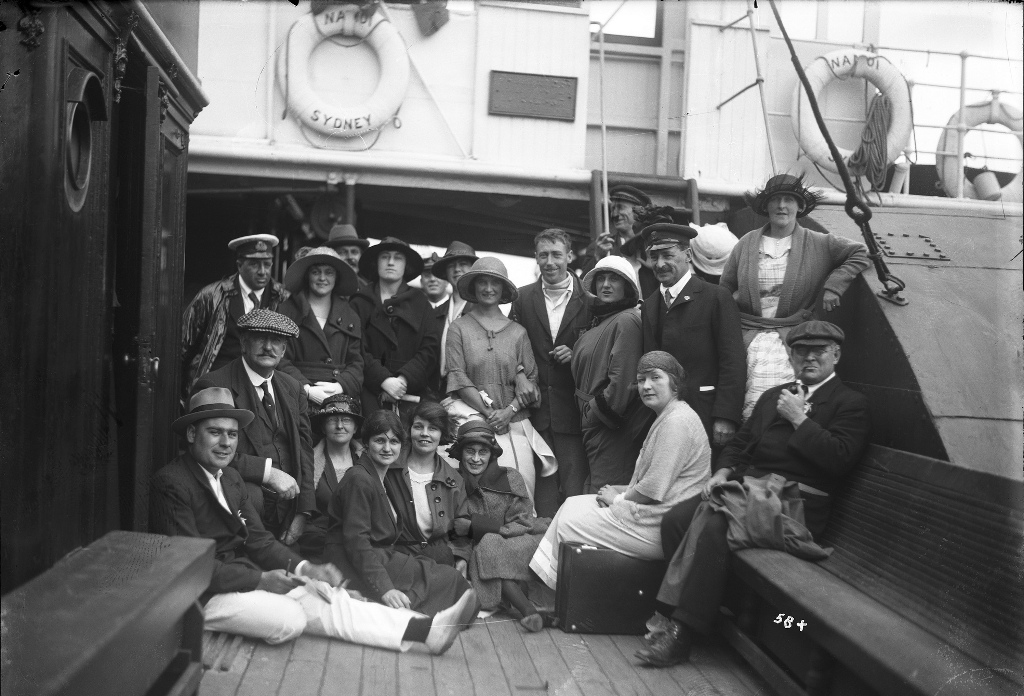
Spectators onboard NAMOI, 1921 Pittwater Regatta (is the young lady with the hat and glasses at front, 3rd from right, a young Nano Roche? - are there any other Roche's aboard?) image courtesy Australian National Maritime Musueum. Image No: 00012160 from their William Hall collection of photos.
Matriarchs of Pittwater I - Katherine Mary Roche - threads collected and collated by A J Guesdon, 2015.